-
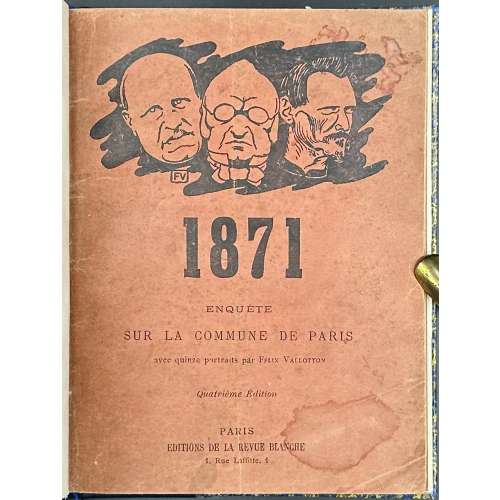 Hardcover, 20.2 x 15.5 cm, owner’s half blue morocco binding over marbled boards with gilt lettering to spine, marbled endpapers, extracts from La Revue Blanche, numbers 91 and 92 of March 15 and April 1 of 1897 (année VII, tome XII), publisher’s pink wrappers preserved, pp. [2] [1-5] 6-160. Ref.: Bridget Alsdorf. Vallotton, Fénéon, and the Legacy of the Commune in Fin-de-siècle France. Portraits: François [Quico] Merlin Colonel Merlin (French, 1814 – 1900) Adolphe Thiers (French, 1797 – 1877) Commandant Gaveau Fortuné Henry (French, 1821 – 1882) Otto von Bismarck (German, 1815 – 1898) Henri, comte de Chambord (French, 1820 – 1883) Louis Rossel (French, 1844 – 1871) François Huet Tranquille (French, 1842 – after 1879) Joseph Vinoy (French, 1803 – 1880) Raoul Rigault (French, 1846 – 1871) Eugène Varlin (French, 1839 – 1871) Théophile Ferré (French, 1845 – 1871) Georges Darboy (French, 1813 – 1871) Auguste Vermorel (French, 1841 – 1871) Jaroslaw Dombrowski [Jarosław Dąbrowski] (Polish-French, 1836 – 1871) Contributors: Félix Fénéon (French, 1861 – 1944) Félix Vallotton (French, 1865 – 1925) La Revue Blanche (Paris) Imprimerie Alcan-Lévy
Hardcover, 20.2 x 15.5 cm, owner’s half blue morocco binding over marbled boards with gilt lettering to spine, marbled endpapers, extracts from La Revue Blanche, numbers 91 and 92 of March 15 and April 1 of 1897 (année VII, tome XII), publisher’s pink wrappers preserved, pp. [2] [1-5] 6-160. Ref.: Bridget Alsdorf. Vallotton, Fénéon, and the Legacy of the Commune in Fin-de-siècle France. Portraits: François [Quico] Merlin Colonel Merlin (French, 1814 – 1900) Adolphe Thiers (French, 1797 – 1877) Commandant Gaveau Fortuné Henry (French, 1821 – 1882) Otto von Bismarck (German, 1815 – 1898) Henri, comte de Chambord (French, 1820 – 1883) Louis Rossel (French, 1844 – 1871) François Huet Tranquille (French, 1842 – after 1879) Joseph Vinoy (French, 1803 – 1880) Raoul Rigault (French, 1846 – 1871) Eugène Varlin (French, 1839 – 1871) Théophile Ferré (French, 1845 – 1871) Georges Darboy (French, 1813 – 1871) Auguste Vermorel (French, 1841 – 1871) Jaroslaw Dombrowski [Jarosław Dąbrowski] (Polish-French, 1836 – 1871) Contributors: Félix Fénéon (French, 1861 – 1944) Félix Vallotton (French, 1865 – 1925) La Revue Blanche (Paris) Imprimerie Alcan-Lévy -
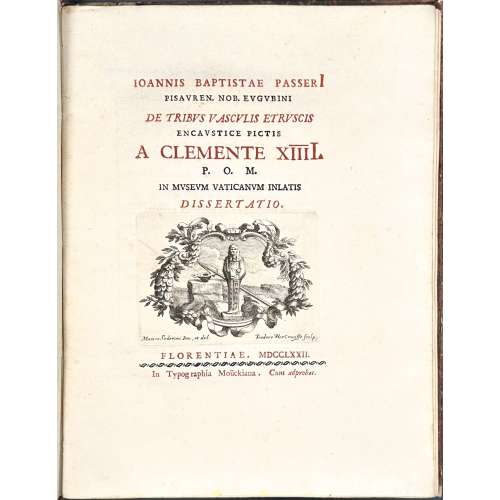 Owner’s wrappers, 28 x 21 cm, printed on laid paper, unpaginated, collated ffl, [A, B]4 C-G4, 2 ffl; total 28 leaves plus 5 engraved plates by Allegrini after Mariotti; engraved title-page (Vercruys after Soderini), head- and tailpieces (Gregori after del Moro) and initials. Owner's label to front pastedown: Marc Burdin, prêtre. Title-page (engraved, red and black): IOANNIS BAPTISTAE PASSERI | PISAUREN. NOB. EUGUBINI | DE TRIBUS VASCULIS ETRUSCIS | ENCAUSTICE PICTIS | A CLEMENTE XIIII. | P.O.M. | IN MUSEUM VATICANUM INLATIS | DISSERTATIO. | {VIGNETTE} | FLORENTIAE. MDCCLXXII. | ~ | in Typographia Moückiana. Cum adprobat. || Dedication: ANTIQVARIAE. ERVDITIONIS. PROPAGATORI EXIMIO ABSOLVTISSIMAM . HANC. DISSERTATIONEM CLARISS. PASSERII DE . IMAGINIBVS . ET . SYMBOLIS TRIVM . VASORVM . ETRVSCI . OPERIS QVAE PRINCIPIS. NOSTRI.SANCTISS. ET. SAPIENTISS. LARGITATE IN . VATICANVM . MVSEVM A. SE. CVMVLATISSIME . DITATVM INVE CTA . FVERVNT REGINALDVS.COMES.ANSIDAEVS.PATR.PERVS. M. A. CARD. PRONEPOS DEVOTVS. NOMINI . MAIESTATIQVE . EIVS DEMISSISSIME. Translation: "To the most excellent promoter of antiquities, the most accomplished: This most complete dissertation concerning the images and symbols of three Etruscan vases, which were most abundantly bestowed by our most holy and wise Prince onto the Vatican museum, was composed by the illustrious Passerius. Reginald, Count of Ansidius, true ancestral father, grandson by blood of the Cardinal, devoted most humbly and devoutly to his name and majesty." Note: P.O.M. stands for "Papa Optimo Maximo", which translates to "Father Most Excellent." For a similar vase in this collection, see VO-0098.
Owner’s wrappers, 28 x 21 cm, printed on laid paper, unpaginated, collated ffl, [A, B]4 C-G4, 2 ffl; total 28 leaves plus 5 engraved plates by Allegrini after Mariotti; engraved title-page (Vercruys after Soderini), head- and tailpieces (Gregori after del Moro) and initials. Owner's label to front pastedown: Marc Burdin, prêtre. Title-page (engraved, red and black): IOANNIS BAPTISTAE PASSERI | PISAUREN. NOB. EUGUBINI | DE TRIBUS VASCULIS ETRUSCIS | ENCAUSTICE PICTIS | A CLEMENTE XIIII. | P.O.M. | IN MUSEUM VATICANUM INLATIS | DISSERTATIO. | {VIGNETTE} | FLORENTIAE. MDCCLXXII. | ~ | in Typographia Moückiana. Cum adprobat. || Dedication: ANTIQVARIAE. ERVDITIONIS. PROPAGATORI EXIMIO ABSOLVTISSIMAM . HANC. DISSERTATIONEM CLARISS. PASSERII DE . IMAGINIBVS . ET . SYMBOLIS TRIVM . VASORVM . ETRVSCI . OPERIS QVAE PRINCIPIS. NOSTRI.SANCTISS. ET. SAPIENTISS. LARGITATE IN . VATICANVM . MVSEVM A. SE. CVMVLATISSIME . DITATVM INVE CTA . FVERVNT REGINALDVS.COMES.ANSIDAEVS.PATR.PERVS. M. A. CARD. PRONEPOS DEVOTVS. NOMINI . MAIESTATIQVE . EIVS DEMISSISSIME. Translation: "To the most excellent promoter of antiquities, the most accomplished: This most complete dissertation concerning the images and symbols of three Etruscan vases, which were most abundantly bestowed by our most holy and wise Prince onto the Vatican museum, was composed by the illustrious Passerius. Reginald, Count of Ansidius, true ancestral father, grandson by blood of the Cardinal, devoted most humbly and devoutly to his name and majesty." Note: P.O.M. stands for "Papa Optimo Maximo", which translates to "Father Most Excellent." For a similar vase in this collection, see VO-0098.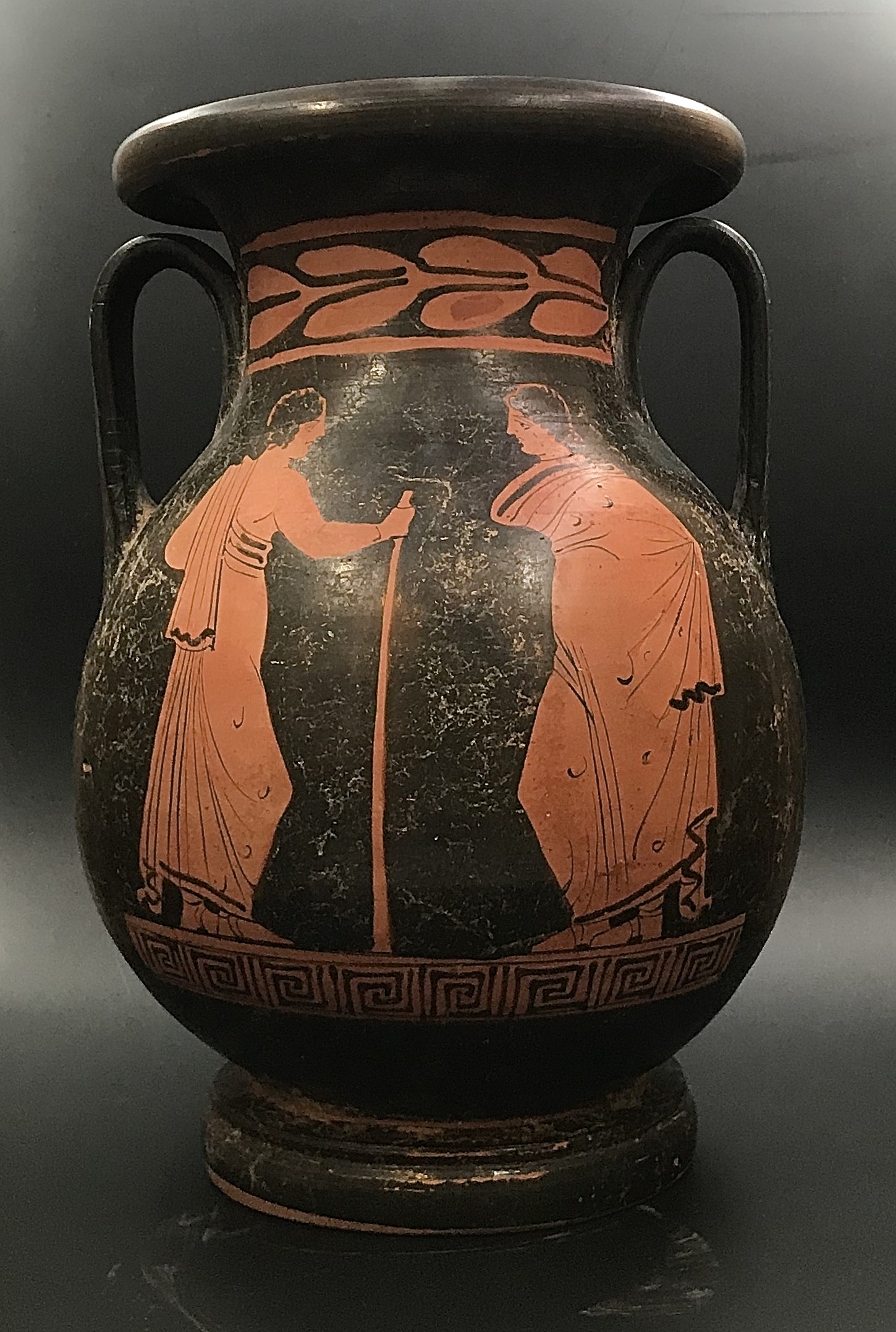
 This vase is attributed to Apulia, ca. 330 BCE. Passeri was probably wrong to attribute this type of vessel to Etruscan vase painting, produced from the 7th through the 4th centuries BC.
Contributors:
Giovanni Battista Passeri (Italian, 1694 – 1780) – author.
Francesco Moücke (Italian, fl. 1729 – 1787) – publisher.
Pope Clement XIV [Ganganelli, Giovanni Vincenzo Antonio] (Italian, 1705 – 1774) – dedicatee.
Artists:
Mauro Soderini (Italian, 1704 – after 1751)
Carlo Spiridione Mariotti (Italian, 1726 – 1790)
Lorenzo del Moro (Italian, 1677 – 1735)
Engravers:
Theodor Vercruys [Teodoro Vercruysse] (Dutch, 1678 – 1739)
Francesco Allegrini da Gubbio (Italian, 1587 – 1663)
Carlo Bartolomeo Gregori (Italian, 1702 – 1759)
This vase is attributed to Apulia, ca. 330 BCE. Passeri was probably wrong to attribute this type of vessel to Etruscan vase painting, produced from the 7th through the 4th centuries BC.
Contributors:
Giovanni Battista Passeri (Italian, 1694 – 1780) – author.
Francesco Moücke (Italian, fl. 1729 – 1787) – publisher.
Pope Clement XIV [Ganganelli, Giovanni Vincenzo Antonio] (Italian, 1705 – 1774) – dedicatee.
Artists:
Mauro Soderini (Italian, 1704 – after 1751)
Carlo Spiridione Mariotti (Italian, 1726 – 1790)
Lorenzo del Moro (Italian, 1677 – 1735)
Engravers:
Theodor Vercruys [Teodoro Vercruysse] (Dutch, 1678 – 1739)
Francesco Allegrini da Gubbio (Italian, 1587 – 1663)
Carlo Bartolomeo Gregori (Italian, 1702 – 1759) -
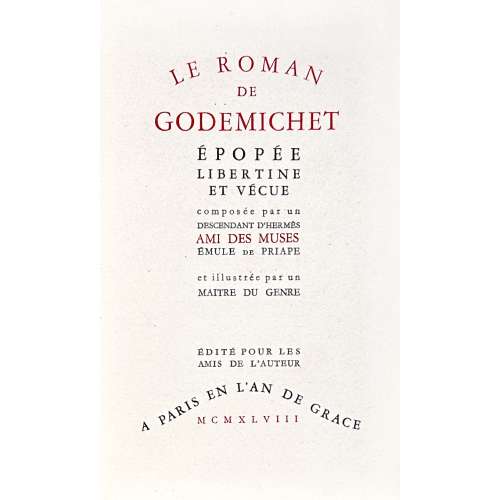 Softcover volume, 23.5 x 15 cm, in tan French flapped wrappers with red lettering to front, collated in-4to, in a tan double slipcase 24 x 15 cm with red lettered label to spine, pp.: [1-12] 13-112 [8], total 120 pages, incl. those within wrappers; printed on thick wove paper watermarked “Lafuma Frères”, 5 full-page and 6 half-page illustrations within collation, incl. frontispiece, guard tissue laid in. Title-page (red and black): LE ROMAN | DE | GODEMICHET | ÉPOPÉE | LIBERTINE | ET VÉCUE | composée par un | DESCENDANT D’HERMES | AMI DES MUSES | ÉMULE DE PRIAPE | et illustrée par un | MAITRE DU GENRE | ÉDITÉ POUR LES | AMIS DE L’AUTEUR | A PARIS EN L’AN DE GRACE | MCMXLVIII || Limited edition 200 + XX, this is copy № 175. Catalogue raisonné: Dutel III № 2336. Jean Reschofsky (French, 1905 – 1998) – artist.
Softcover volume, 23.5 x 15 cm, in tan French flapped wrappers with red lettering to front, collated in-4to, in a tan double slipcase 24 x 15 cm with red lettered label to spine, pp.: [1-12] 13-112 [8], total 120 pages, incl. those within wrappers; printed on thick wove paper watermarked “Lafuma Frères”, 5 full-page and 6 half-page illustrations within collation, incl. frontispiece, guard tissue laid in. Title-page (red and black): LE ROMAN | DE | GODEMICHET | ÉPOPÉE | LIBERTINE | ET VÉCUE | composée par un | DESCENDANT D’HERMES | AMI DES MUSES | ÉMULE DE PRIAPE | et illustrée par un | MAITRE DU GENRE | ÉDITÉ POUR LES | AMIS DE L’AUTEUR | A PARIS EN L’AN DE GRACE | MCMXLVIII || Limited edition 200 + XX, this is copy № 175. Catalogue raisonné: Dutel III № 2336. Jean Reschofsky (French, 1905 – 1998) – artist. -
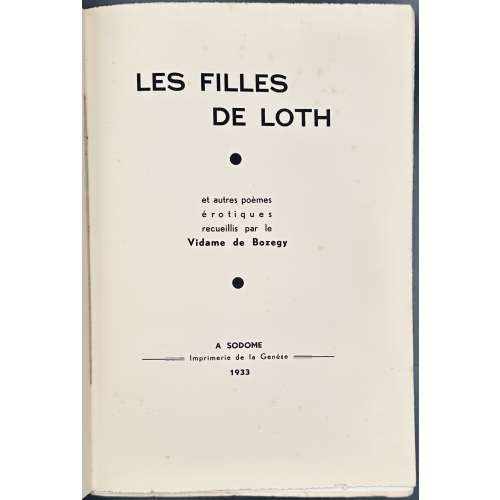 Softcover, french flapped wrappers, 29 x 19 cm, in glassine dustjacket, text printed on laid paper, pp.: [1-10] 11-256 [8], total 264 pages plus 11 plates out of 12, hand-coloured etchings on wove paper laid in, extraneous to collation. Wrappers detached from the block. Some pages uncut. Below is the missing plate, according to honesterotica.com:
Softcover, french flapped wrappers, 29 x 19 cm, in glassine dustjacket, text printed on laid paper, pp.: [1-10] 11-256 [8], total 264 pages plus 11 plates out of 12, hand-coloured etchings on wove paper laid in, extraneous to collation. Wrappers detached from the block. Some pages uncut. Below is the missing plate, according to honesterotica.com: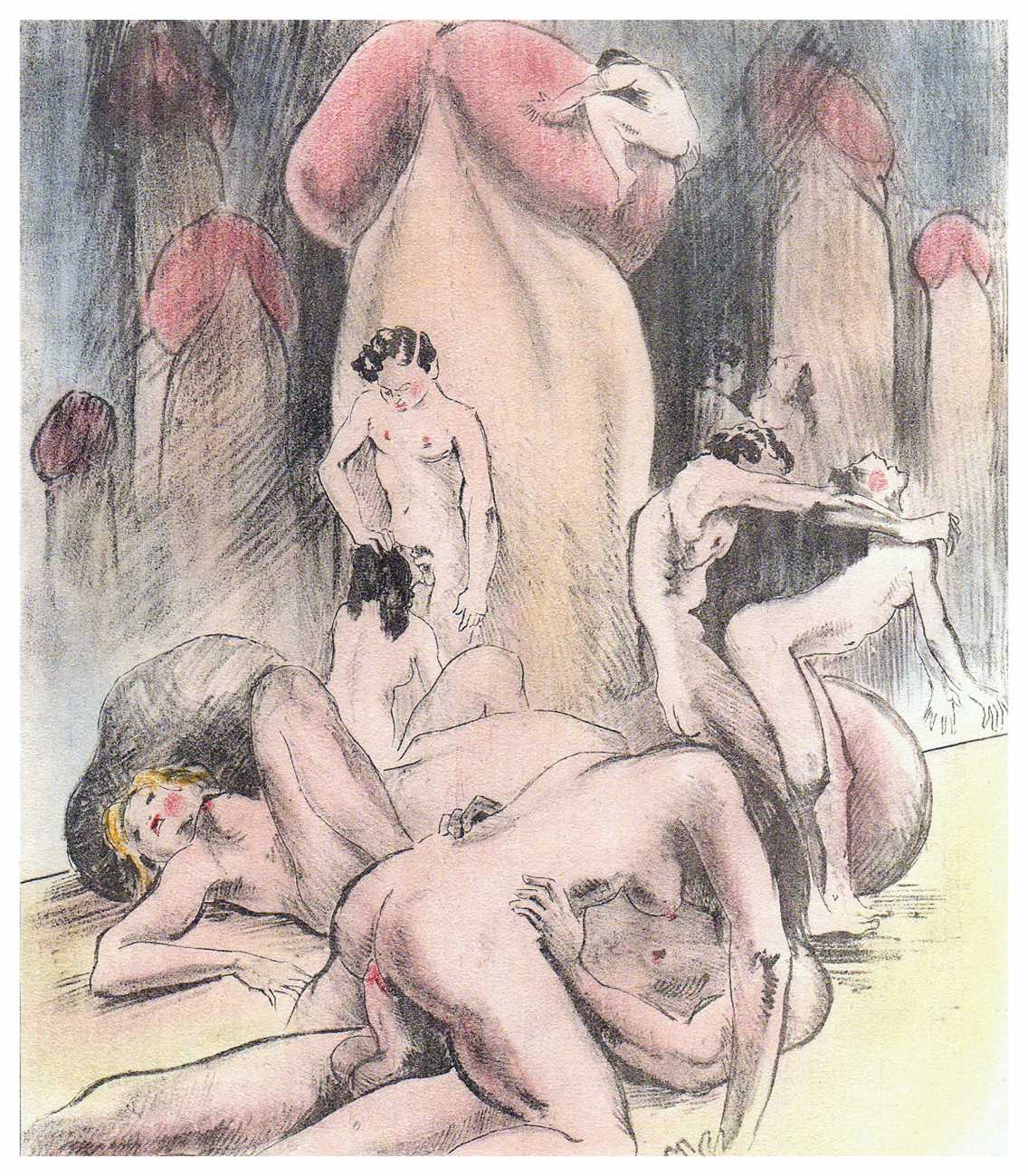 Title-page: LES FILLES | DE LOTH | • | et autres poèmes | érotiques | recueillis par le | Vidame de Bozegy | • | A SODOME | — Imprimerie de la Genèse — | 1933 ||
Edition limited to 500 copies, this is copy № 54.
Catalogue raisonné: Dutel III № 1575.
Edmond Dardenne Bernard [Vidame de Bozegy] (French, 20th c.) – author.
André Collot (French, 1897 – 1976) – artist.
Title-page: LES FILLES | DE LOTH | • | et autres poèmes | érotiques | recueillis par le | Vidame de Bozegy | • | A SODOME | — Imprimerie de la Genèse — | 1933 ||
Edition limited to 500 copies, this is copy № 54.
Catalogue raisonné: Dutel III № 1575.
Edmond Dardenne Bernard [Vidame de Bozegy] (French, 20th c.) – author.
André Collot (French, 1897 – 1976) – artist. -
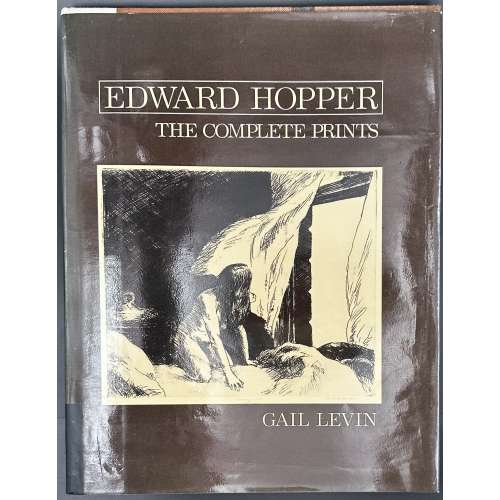 Hardcover volume, 28.6 x 22.4 cm, tan cloth over brown cloth boards, black lettering to spine, blind-stamped lettering in frame to front, in a black pictorial dust jacket, price unclipped; pp.: [1-ix] x-xi [xii blank], [1-4] 5-36 [4], 64 pages with 109 b/w plates, 12 pages with chronology, bibliography, credits; total 128 pp. Title-page: EDWARD HOPPER (in frame)| THE COMPLETE PRINTS | GAIL LEVIN | W • W • NORTON & COMPANY • NEW YORK • LONDON | IN ASSOCIATION WITH THE | WHITNEY MUSEUM OF AMERICAN ART || Contributors: Gail Levin (American, b. 1948) – author. Edward Hopper (American, 1882 – 1967) – artist. W. W. Norton & Company (f. 1923) – publisher. Whitney Museum of American Art (NY) – publisher.
Hardcover volume, 28.6 x 22.4 cm, tan cloth over brown cloth boards, black lettering to spine, blind-stamped lettering in frame to front, in a black pictorial dust jacket, price unclipped; pp.: [1-ix] x-xi [xii blank], [1-4] 5-36 [4], 64 pages with 109 b/w plates, 12 pages with chronology, bibliography, credits; total 128 pp. Title-page: EDWARD HOPPER (in frame)| THE COMPLETE PRINTS | GAIL LEVIN | W • W • NORTON & COMPANY • NEW YORK • LONDON | IN ASSOCIATION WITH THE | WHITNEY MUSEUM OF AMERICAN ART || Contributors: Gail Levin (American, b. 1948) – author. Edward Hopper (American, 1882 – 1967) – artist. W. W. Norton & Company (f. 1923) – publisher. Whitney Museum of American Art (NY) – publisher. -
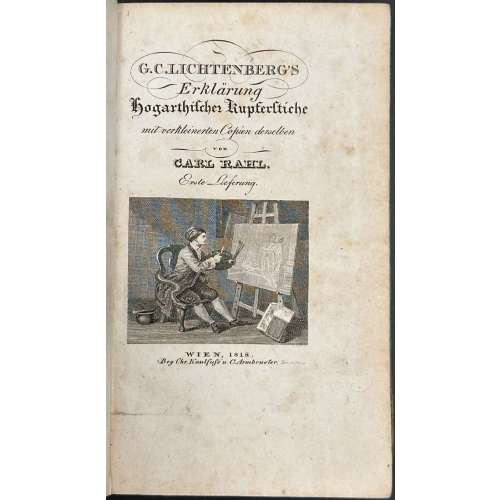 Three hardcover volumes, in-12mo, 16.2 x 10.6 cm each, uniformly bound in quarter brown cloth over marbled boards, all margins marbled, gilt lettering to spine; plus an oblong volume of similar binding, 24.5 x 39.5 cm, with 88 engraved plates by Riepenhausen after Hogarth (83 pp, unnumbered). Catalogue raisonné of William Hogarth's engravings, published by Carl Armbruster in Vienna and Dieterichsche Buchhandlung in Göttingen. A detailed explanation of Hogarth's prints divided in 14 parts. Vol. 1.
Three hardcover volumes, in-12mo, 16.2 x 10.6 cm each, uniformly bound in quarter brown cloth over marbled boards, all margins marbled, gilt lettering to spine; plus an oblong volume of similar binding, 24.5 x 39.5 cm, with 88 engraved plates by Riepenhausen after Hogarth (83 pp, unnumbered). Catalogue raisonné of William Hogarth's engravings, published by Carl Armbruster in Vienna and Dieterichsche Buchhandlung in Göttingen. A detailed explanation of Hogarth's prints divided in 14 parts. Vol. 1.- C. G. Lichtenberg’s Ausführliche Erklärung der Hogarthischen Kupferstiche, mit verkleinerten Copien derselben von Carl Rahl. Erste Lieferung. Wien, 1818. Bey Chr. Kaulfuß und C. Armbruster. Gedruckt bey Anton Strauß. [i-v] vi-xxxvi, [1-3] 4-136, plus engraved t.p.
- C. G. Lichtenberg’s Ausführliche Erklärung der Hogarthischen Kupferstiche, mit verkleinerten Copien derselben von Carl Rahl. Zweite Lieferung. Wien, 1818. Bey Chr. Kaulfuß und C. Armbruster. Gedruckt bey Anton Strauß. [i-iii] iv-viii [2] 11-207 [1 blank], plus engraved t.p.
- C. G. Lichtenberg’s Ausführliche Erklärung der Hogarthischen Kupferstiche, mit verkleinerten Copien derselben von Carl Rahl. Dritte Lieferung. Wien, 1818. Bey Chr. Kaulfuß und C. Armbruster. Gedruckt bey Anton Strauß. [i-iii] iv-vi [3] 10-215 [1 blank], plus engraved t.p.
- C. G. Lichtenberg’s Ausführliche Erklärung der Hogarthischen Kupferstiche, mit verkleinerten Copien derselben von Carl Rahl. Vierte Lieferung. Wien, 1818. Bey Chr. Kaulfuß und C. Armbruster. Gedruckt bey Anton Strauß. [1-5] 6-180 [1 blank], plus engraved t.p.
- C. G. Lichtenberg’s Ausführliche Erklärung der Hogarthischen Kupferstiche, mit verkleinerten Copien derselben von Carl Rahl. Fünste Lieferung. Wien, bey Carl Armbruster 1819. Gedruckt bey Anton Strauß. [1-3] 4-144, plus engraved t.p.
- C. G. Lichtenberg’s Ausführliche Erklärung der Hogarthischen Kupferstiche, mit verkleinerten Copien derselben von Carl Rahl. Sechste Lieferung. Mit zufåßen nach den schriften der englischen Erflårer. Wien, bey Carl Armbruster 1819. Gedruckt bey Anton Strauß. [i-iii] iv-x [2] 13-100, plus engraved t.p.
- C. G. Lichtenberg’s Ausführliche Erklärung der Hogarthischen Kupferstiche, mit verkleinerten Copien derselben von Carl Rahl. Siebente und achte Lieferung. Mit zufåßen nach den Schriften der englischen Erflårer. Wien, bey Carl Armbruster 1820. Gedruckt bey Anton Strauß. [1-8] 9-191, plus engraved t.p.
- C. G. Lichtenberg’s Ausführliche Erklärung der Hogarthischen Kupferstiche, mit verkleinerten Copien derselben von Carl Rahl. Neunte und zehnte Lieferung. Mit zufåßen nach den Schriften der englischen Erflårer. Wien, bey Carl Armbruster 1823. Gedruckt bey Anton Strauß. [1-7] 8-168, plus engraved t.p.
- C. G. Lichtenberg’s Erklärung der Hogarthischen Kupferstiche, mit verkleinerten aber vollständigen Copien derselben von E. Riepenhausen. Eilfte Lieferung mit zufåßen nach den schriften der englischen Erflårer. Göttingen in der Dieterichsche Buchhandlung 1809. [1-3] 4-81 [82 blank].
- C. G. Lichtenberg’s Ausführliche Erklärung der Hogarthischen Kupferstiche, mit verkleinerten aber vollständigen Copien derselben von E. Riepenhausen fortgefeßt vom Berausgeber der fechsten Lieferung mit Benußung der englischen Erflårer. Zwölfte Lieferung. Göttingen in der Dieterichsche Buchhandlung 1816. [i-iii] iv [1-3] 4-76.
- J. P. Lyser’s Ausführliche Erklärung der Hogarthischen Kupferstiche, mit verkleinerten aber vollständigen Copien derselben von E. Riepenhausen. Dreizehnte Lieferung Göttingen in der Dieterichsche Buchhandlung 1833. [i-v] vi-xii, [1-3] 4-117 [118].
- Dr. le Petit’s Ausführliche Erklärung der Hogarthischen Kupferstiche, mit verkleinerten aber vollständigen Copien derselben von E. Riepenhausen, Berausgeber Karl Gutzkow. Vierzehnte Lieferung. Göttingen in der Dieterichsche Buchhandlung 1835. [i-iii] iv-xvi, [1-3] 4-132.
-
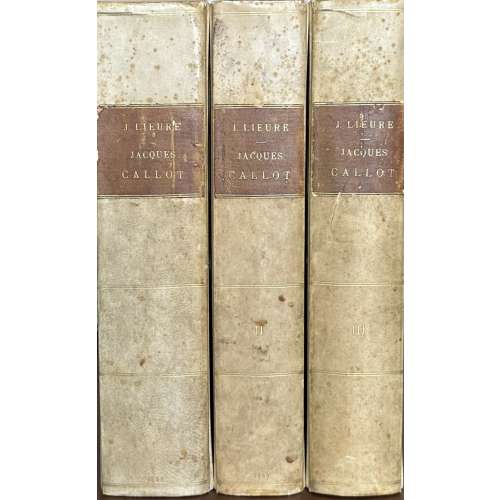 Three volumes, 33 x 26.5 x 7 cm each, uniformly bound in 2/3 vellum over marbled boards, outlined with gilt fillet, brown label with gilt lettering to flat spine with double fillet faux-bands, marbled endpapers, top edge gilt, other untrimmed, publisher’s wrappers preserved, incl. spine; collotype plates with captioned glassine guards; armorial bookplate of Comte Alain de Suzannet to front pastedown in each volume. Two volumes of Première partie, wanting, contain La vie artistique : texte and La vie artistique : planches. Title-page (red and black): JACQUES CALLOT | PAR | J. LIEURE | Introduction de F. Courboin | Conservateur du Cabinet des Estampes à la Bibliothèque Nationale | — | DEUXIÈME PARTIE | CATALOGUE DE L’ŒUVRE GRAVÉ | TOME I (II, III) | — | PARIS | ÉDITIONS DE LA GAZETTE DES BEAUX-ARTS | 106, Boulevard Saint-Germain (6e) | 1924 (1927, 1927) || Vol. 1 (1924): [4] [1] 2-122 [2], wrappers, plates 1-299; printed on September 15, 1924, by André Lesot (Nemours) and D. Jacomet et Cie (Paris). Vol. 2 (1927): [4] [1] 2-106 [2], wrappers, plates 300-652. Vol. 3 (1927): [4] [1] 2-128 [4], wrappers, plates 653-1428; printed on September 5, 1926, by Imprimerie moderne des Beaux-Arts (Bois-Colombes) and D. Jacomet et Cie (Paris). Contributors: Jules Lieure (French, 1866 – 1948) – author. Jacques Callot (French, c. 1592 – 1635) – artist. Gazette des Beaux-Arts (f. 1859) – publisher. François Courboin (French, 1865 – 1926) – author. D. Jacomet et Cie (Paris) – printer. Daniel Jacomet (French, 1894 – 1966) – printer. André Lesot (French, 1874-1951) – printer. Imprimerie moderne des Beaux-Arts (Bois-Colombes) Comte Alain de Suzannet (French, 1882 – 1950) – provenance.
Three volumes, 33 x 26.5 x 7 cm each, uniformly bound in 2/3 vellum over marbled boards, outlined with gilt fillet, brown label with gilt lettering to flat spine with double fillet faux-bands, marbled endpapers, top edge gilt, other untrimmed, publisher’s wrappers preserved, incl. spine; collotype plates with captioned glassine guards; armorial bookplate of Comte Alain de Suzannet to front pastedown in each volume. Two volumes of Première partie, wanting, contain La vie artistique : texte and La vie artistique : planches. Title-page (red and black): JACQUES CALLOT | PAR | J. LIEURE | Introduction de F. Courboin | Conservateur du Cabinet des Estampes à la Bibliothèque Nationale | — | DEUXIÈME PARTIE | CATALOGUE DE L’ŒUVRE GRAVÉ | TOME I (II, III) | — | PARIS | ÉDITIONS DE LA GAZETTE DES BEAUX-ARTS | 106, Boulevard Saint-Germain (6e) | 1924 (1927, 1927) || Vol. 1 (1924): [4] [1] 2-122 [2], wrappers, plates 1-299; printed on September 15, 1924, by André Lesot (Nemours) and D. Jacomet et Cie (Paris). Vol. 2 (1927): [4] [1] 2-106 [2], wrappers, plates 300-652. Vol. 3 (1927): [4] [1] 2-128 [4], wrappers, plates 653-1428; printed on September 5, 1926, by Imprimerie moderne des Beaux-Arts (Bois-Colombes) and D. Jacomet et Cie (Paris). Contributors: Jules Lieure (French, 1866 – 1948) – author. Jacques Callot (French, c. 1592 – 1635) – artist. Gazette des Beaux-Arts (f. 1859) – publisher. François Courboin (French, 1865 – 1926) – author. D. Jacomet et Cie (Paris) – printer. Daniel Jacomet (French, 1894 – 1966) – printer. André Lesot (French, 1874-1951) – printer. Imprimerie moderne des Beaux-Arts (Bois-Colombes) Comte Alain de Suzannet (French, 1882 – 1950) – provenance. -
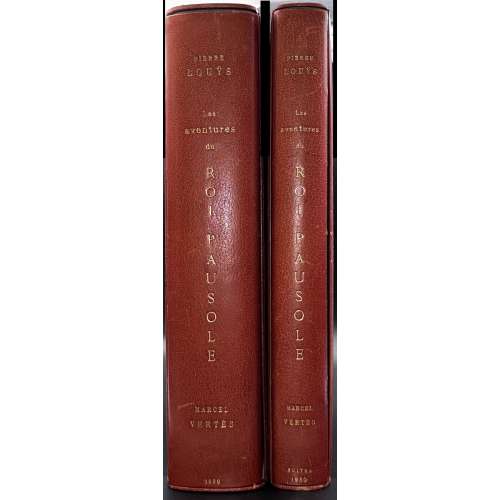 Two volumes in owner’s uniform so called Jansenist binding by someone Alix (signed in gilt inside), gilt lettering to spine, each in a slipcase. Vol. 1: full crimson morocco 32.5 x 26 x 6.5 cm in a 33.3 x 27 x 7 cm slipcase, cloth endpapers, all edges gilt, publisher’s wrappers preserved, autographed drawing by Vertès to h.t. “à monsieur Willard | bien sympathiquement | Vertès | Paris 1930”. Collation: 3 blanks, front wrapper, 2 blanks, [10] h.t./limit., t.p., art., dedic., person., [2] 3-487 [488 blank], [2] coloph., 3 blanks, spine, 3 blanks; 74 dry-point illustrations by Marcel Vertès within collation; printed on thick wove paper by ‘Arches’ watermarked “Pausole & Vertès”. Title-page (red and black): LES AVENTURES | DU | ROI PAUSOLE | de | PIERRE LOUŸS | {vignette} | AUX DÉPENS D'UN AMATEUR | PARIS, MCMXXX || Limitation: CETTE ÉDITION DU ROMAN | DE |PIERRE LOUŸS | LES AVENTURES DU ROI PAUSOLE | A ÉTE COMPOSE EN CARACTÈRE GARAMOND DU CORPS 18 | ET IMPRIMEE SUR VÉLIN A LA FORME DES PAPETERIES | D' ARCHES FILIGRANÉ | PAUSOLE & VERTÈS | ELLE EST ILLUSTRÉE DE SOIXANTE-QUATORZE | POINTES-SÈCHES ORIGINALES | DE | VERTÈS | SON TIRAGE A ÉTÉ STRICTEMENT LIMITÉ A | QUATRE-VINGT-DIX-NEUF EXEMPLAIRES NUMÉROTÉS | DE 1 A 99 ET CONTENANT : | 1° LA SUITE DES CUIVRES AVEC REMAROUES. | 2° UNE SUITE DES 15 PLANCHES REFUSÉES. | IL A ÉTÉ TIRÉ EN OUTRE, POUR L' ARTISTE ET LES COLLABORATEURS, | QUELQUES EXEMPLAIRES NOMINATIFS, DONT DEUX IMPRIMÉS SUR PAPIER | CHIFFE D'AUVERGNE A LA MAIN | EXEMPLAIRE | № 9 || Colophon: Cet ouvrage, établi aux dépens de m. L. Givaudan, a été achevé d'imprimer le quinze novembre mil neuf cent trente, pour le texte, sur les presses de R. Coulouma, maitre imprimeur a Argenteuil, H. Barthélemy, directeur, et pour les pointes-sèches, dans les ateliers de «La Tradition", a Paris. Limited edition of 99 copies, this is copy № 9. Vol. 2: Three-quarters crimson morocco over cloth outlined gilt, 32.7 x 27.8 x 4 cm in a 33.3 x 28.2 x 4.3 cm slipcase, cloth endpapers, all edges gilt, printed on thick wove paper by ‘Arches’ watermarked “Pausole & Vertès”. Collation: 3 blanks, 74 unpaginated leaves of plates (main suite avec remarque), blank, 15 leaves of plates (refusées), t.p./limit., blank, 30 leaves of plates (15 prints in two states each, with and without ‘remarks’) titled Au pays du Roi Pausole, 3 blanks. Title-page (red and black): AU PAYS | DU | ROI PAUSOLE | Quinze cuivres | gravés par un artiste | inconnu | de la suite | du Roi | ❦ | —| TRYPHÈME. MCMXXX. || Limitation: IL A ÉTÉ TIRÉDE CETTE SUITE | DE POINTES-SÈCHES VINGT- | CINQ EXEMPLAIRES SUR VÉ- | LIN A LA FORME DES PAPETE- | RIES ARCHES AU FILIGRANE | DE PAUSOLE. CES SUITES NON | MISES DANS LE COMMERCE | SONT RÉSERVÉES A SA MAJES- | TÉ, AUX REINES PRÉFÉRÉES | PARMI LL. AA. RR. ET A QUEL- | QUES FIDÈLES SERVITEURS. | № 13 || Limited edition of 25 copies, this is copy № 13; Enriched with an original copper plate with one of the illustrations. Marcel Willard (French, – provenance. Catalogue raisonné: Dutel (III) 1057; Nordmann (II) № 307; Vokaer 26. Ref.: honesterotica.com Contributors: Pierre Louÿs (French, 1870 – 1925) – author. Marcel Vertès [Marcell Vértes] (Jewish-Hungarian-French, 1895 – 1961) – artist. Léon Givaudan (French, 1875 – 1936) – publisher. Seller's description:Les Aventures du Roi Pausole. Paris, Aux dépens d'un amateur, 1930. 2 volumes in-4, maroquin rouge janséniste, tranches dorée, couverture et dos, emboîtage. Le volume de suites est relié en demi-maroquin rouge. (Alix). Ouvrage illustré de 74 pointes-sèches de Marcel Vertès. Tirage à 99 exemplaires sur vélin d'Arches, comportant la suite des cuivres avec remarque, ainsi qu'une suite des 15 planches refusées. Exemplaire enrichi d'une plaque de cuivre ayant servi à une des illustrations, d'un dessin avec envoi autographe signé de l'artiste sur la page de faux-titre et d'une double suite des 15 pointes-sèches par un artiste inconnu intitulée Au Pays du roi Pausole. Dos légèrement passés.
Two volumes in owner’s uniform so called Jansenist binding by someone Alix (signed in gilt inside), gilt lettering to spine, each in a slipcase. Vol. 1: full crimson morocco 32.5 x 26 x 6.5 cm in a 33.3 x 27 x 7 cm slipcase, cloth endpapers, all edges gilt, publisher’s wrappers preserved, autographed drawing by Vertès to h.t. “à monsieur Willard | bien sympathiquement | Vertès | Paris 1930”. Collation: 3 blanks, front wrapper, 2 blanks, [10] h.t./limit., t.p., art., dedic., person., [2] 3-487 [488 blank], [2] coloph., 3 blanks, spine, 3 blanks; 74 dry-point illustrations by Marcel Vertès within collation; printed on thick wove paper by ‘Arches’ watermarked “Pausole & Vertès”. Title-page (red and black): LES AVENTURES | DU | ROI PAUSOLE | de | PIERRE LOUŸS | {vignette} | AUX DÉPENS D'UN AMATEUR | PARIS, MCMXXX || Limitation: CETTE ÉDITION DU ROMAN | DE |PIERRE LOUŸS | LES AVENTURES DU ROI PAUSOLE | A ÉTE COMPOSE EN CARACTÈRE GARAMOND DU CORPS 18 | ET IMPRIMEE SUR VÉLIN A LA FORME DES PAPETERIES | D' ARCHES FILIGRANÉ | PAUSOLE & VERTÈS | ELLE EST ILLUSTRÉE DE SOIXANTE-QUATORZE | POINTES-SÈCHES ORIGINALES | DE | VERTÈS | SON TIRAGE A ÉTÉ STRICTEMENT LIMITÉ A | QUATRE-VINGT-DIX-NEUF EXEMPLAIRES NUMÉROTÉS | DE 1 A 99 ET CONTENANT : | 1° LA SUITE DES CUIVRES AVEC REMAROUES. | 2° UNE SUITE DES 15 PLANCHES REFUSÉES. | IL A ÉTÉ TIRÉ EN OUTRE, POUR L' ARTISTE ET LES COLLABORATEURS, | QUELQUES EXEMPLAIRES NOMINATIFS, DONT DEUX IMPRIMÉS SUR PAPIER | CHIFFE D'AUVERGNE A LA MAIN | EXEMPLAIRE | № 9 || Colophon: Cet ouvrage, établi aux dépens de m. L. Givaudan, a été achevé d'imprimer le quinze novembre mil neuf cent trente, pour le texte, sur les presses de R. Coulouma, maitre imprimeur a Argenteuil, H. Barthélemy, directeur, et pour les pointes-sèches, dans les ateliers de «La Tradition", a Paris. Limited edition of 99 copies, this is copy № 9. Vol. 2: Three-quarters crimson morocco over cloth outlined gilt, 32.7 x 27.8 x 4 cm in a 33.3 x 28.2 x 4.3 cm slipcase, cloth endpapers, all edges gilt, printed on thick wove paper by ‘Arches’ watermarked “Pausole & Vertès”. Collation: 3 blanks, 74 unpaginated leaves of plates (main suite avec remarque), blank, 15 leaves of plates (refusées), t.p./limit., blank, 30 leaves of plates (15 prints in two states each, with and without ‘remarks’) titled Au pays du Roi Pausole, 3 blanks. Title-page (red and black): AU PAYS | DU | ROI PAUSOLE | Quinze cuivres | gravés par un artiste | inconnu | de la suite | du Roi | ❦ | —| TRYPHÈME. MCMXXX. || Limitation: IL A ÉTÉ TIRÉDE CETTE SUITE | DE POINTES-SÈCHES VINGT- | CINQ EXEMPLAIRES SUR VÉ- | LIN A LA FORME DES PAPETE- | RIES ARCHES AU FILIGRANE | DE PAUSOLE. CES SUITES NON | MISES DANS LE COMMERCE | SONT RÉSERVÉES A SA MAJES- | TÉ, AUX REINES PRÉFÉRÉES | PARMI LL. AA. RR. ET A QUEL- | QUES FIDÈLES SERVITEURS. | № 13 || Limited edition of 25 copies, this is copy № 13; Enriched with an original copper plate with one of the illustrations. Marcel Willard (French, – provenance. Catalogue raisonné: Dutel (III) 1057; Nordmann (II) № 307; Vokaer 26. Ref.: honesterotica.com Contributors: Pierre Louÿs (French, 1870 – 1925) – author. Marcel Vertès [Marcell Vértes] (Jewish-Hungarian-French, 1895 – 1961) – artist. Léon Givaudan (French, 1875 – 1936) – publisher. Seller's description:Les Aventures du Roi Pausole. Paris, Aux dépens d'un amateur, 1930. 2 volumes in-4, maroquin rouge janséniste, tranches dorée, couverture et dos, emboîtage. Le volume de suites est relié en demi-maroquin rouge. (Alix). Ouvrage illustré de 74 pointes-sèches de Marcel Vertès. Tirage à 99 exemplaires sur vélin d'Arches, comportant la suite des cuivres avec remarque, ainsi qu'une suite des 15 planches refusées. Exemplaire enrichi d'une plaque de cuivre ayant servi à une des illustrations, d'un dessin avec envoi autographe signé de l'artiste sur la page de faux-titre et d'une double suite des 15 pointes-sèches par un artiste inconnu intitulée Au Pays du roi Pausole. Dos légèrement passés. -
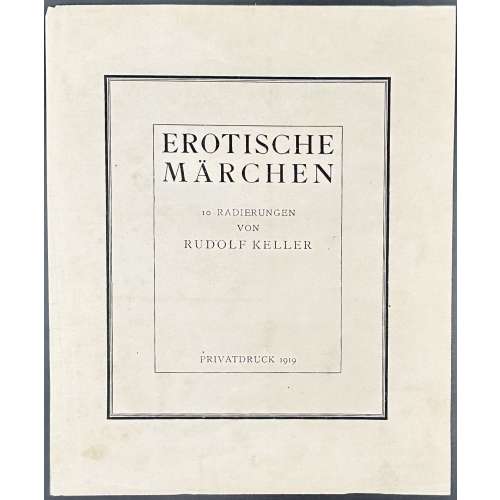 Portfolio 265 x 225 mm, black half-buckram over diapered cardboard with flaps, black with gilt lettering in frame to front “R. KELLER | MÄRCHEN”, t.p. printed on wave paper, the folder and engravings printed on laid paper, 10 loose plates, 240 x 210 mm sheet, 135 x 110-115 mm plate; re-issue of ten plates of the first edition of 16 plates published in Austria in c. 1910s. Title-page: EROTISCHE | MÄRCHEN | 10 RADIERUNGEN | VON | RUDOLF KELLER | PRIVATDRUCK 1919 || Die Mappe enthält folgende originalradierungen: 1. Aschenbrödel; 2. Dornröschen; 3. Zwerg Nase; 4. Froschkönig; 5. Der gestiefelte Kater; 6. Hänsel und Gretel; 7. Der fliegende Koffer; 8. Schneewittchen mit den 7 Zwergen; 9. Die kleine Seejungfer; 10. Der kleine Daumling Dieses Werk wurde in einer einmaligen Auflage von 250 numerierten Exemplaren hergestellt und darf nur an Gelehrte und Sammler abgegeben werden. Die Platten wurden vernichtet. Nr. 1—50 sind vom Künstler signierte Vorzugsdrucke. Dieses Exemplar erhielt Nr. 0153. Translation: The folder contains the following original etchings: 1. Cinderella; 2. Sleeping Beauty; 3. Dwarf nose; 4. The Frog Prince; 5. Puss in Boots; 6. Hansel and Gretel; 7. The Flying Trunk; 8. Snow White with the Seven Dwarfs; 9. The Little Mermaid; 10. Little Thumbling. This work was produced in a one-time edition of 250 numbered copies and may only be sold to scholars and collectors. The copperplates were destroyed. Nos. 1-50 are special prints signed by the artist. This copy was given number 0153. Seller's description: Erotische Märchen. S.l., Privatdruck, 1919. In-8, en feuilles, sous chemise demi-chagrin vert recouverte de papier japonais. Recueil de 10 eaux-fortes originales de Rudolf Keller. Ces eaux-fortes érotiques dans les teintes brunes s'inspirent des contes de fées traditionnels comme Cendrillon, La Belle au bois dormant, Hansel et Gretel, Blanche-Neige, Le Petit Poucet etc. Tirage à 250 exemplaires. Chemise défraîchie. Jacob Grimm (German; 1785 – 1863) Wilhelm Grimm (German, 1786 – 1859) Charles Perrault (French, 1628 – 1703) Hans Christian Andersen (Danish, 1805 – 1875)
Portfolio 265 x 225 mm, black half-buckram over diapered cardboard with flaps, black with gilt lettering in frame to front “R. KELLER | MÄRCHEN”, t.p. printed on wave paper, the folder and engravings printed on laid paper, 10 loose plates, 240 x 210 mm sheet, 135 x 110-115 mm plate; re-issue of ten plates of the first edition of 16 plates published in Austria in c. 1910s. Title-page: EROTISCHE | MÄRCHEN | 10 RADIERUNGEN | VON | RUDOLF KELLER | PRIVATDRUCK 1919 || Die Mappe enthält folgende originalradierungen: 1. Aschenbrödel; 2. Dornröschen; 3. Zwerg Nase; 4. Froschkönig; 5. Der gestiefelte Kater; 6. Hänsel und Gretel; 7. Der fliegende Koffer; 8. Schneewittchen mit den 7 Zwergen; 9. Die kleine Seejungfer; 10. Der kleine Daumling Dieses Werk wurde in einer einmaligen Auflage von 250 numerierten Exemplaren hergestellt und darf nur an Gelehrte und Sammler abgegeben werden. Die Platten wurden vernichtet. Nr. 1—50 sind vom Künstler signierte Vorzugsdrucke. Dieses Exemplar erhielt Nr. 0153. Translation: The folder contains the following original etchings: 1. Cinderella; 2. Sleeping Beauty; 3. Dwarf nose; 4. The Frog Prince; 5. Puss in Boots; 6. Hansel and Gretel; 7. The Flying Trunk; 8. Snow White with the Seven Dwarfs; 9. The Little Mermaid; 10. Little Thumbling. This work was produced in a one-time edition of 250 numbered copies and may only be sold to scholars and collectors. The copperplates were destroyed. Nos. 1-50 are special prints signed by the artist. This copy was given number 0153. Seller's description: Erotische Märchen. S.l., Privatdruck, 1919. In-8, en feuilles, sous chemise demi-chagrin vert recouverte de papier japonais. Recueil de 10 eaux-fortes originales de Rudolf Keller. Ces eaux-fortes érotiques dans les teintes brunes s'inspirent des contes de fées traditionnels comme Cendrillon, La Belle au bois dormant, Hansel et Gretel, Blanche-Neige, Le Petit Poucet etc. Tirage à 250 exemplaires. Chemise défraîchie. Jacob Grimm (German; 1785 – 1863) Wilhelm Grimm (German, 1786 – 1859) Charles Perrault (French, 1628 – 1703) Hans Christian Andersen (Danish, 1805 – 1875) -
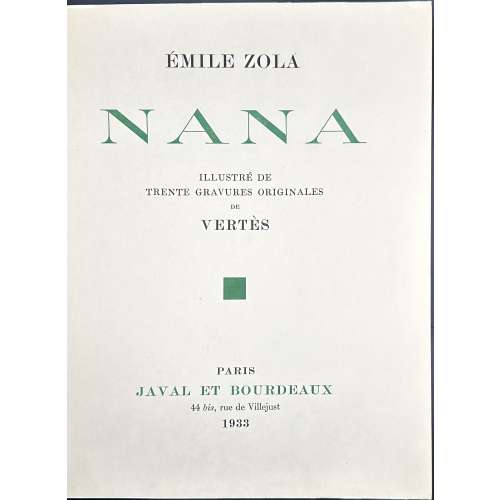 Publisher’s olive French flapped wrappers, in-4to, 33 x 25.3 x 6 cm, green and black lettering to front and spine, in a glassine dust jacket, in a marbled double slipcase 34.5 x 25.5 cm, unbound; pp.: [8] 1-436 [4], plus 30 colour plates with guard tissue, extraneous to collation; edition enriched with a set of 30 uncoloured etchings with guard tissue in a lettered paper folder. Title-page: ÉMILE ZOLA | NANA | ILLUSTRÉ DE | TRENTE GRAVURES ORIGINALES | DE | VERTÈS |◾| PARIS | JAVAL ET BOURDEAUX | 44 bis, rue de Villejust | 1933 || Justification du tirage: il a été tiré de «Nana » d'Émile Zola. Soixante exemplaires sur japon impérial, numérotés de 1 a 60, avec un état en couleurs colorié a la main et un état en noir des trente gravures originales de Vertès. [Edition limited to 60 copies, this is copy № 54]. Colophon: « NANA », D'ÉMILE ZOLA, ÉTÉ ACHEVÉ D'IMPRIMER LE TRENTE AVRIL MIL NEUF CENT TRENTE-TROIS, EN CARACTÈRES ROMAIN ANGLAIS DU CORPS 16, SUR LES PRESSES DU MAITRE IMPRIMEUR COULOUMA, À ARGENTEUIL, H. BARTHÉLEMY, DIRECTEUR. LES COMPOSITIONS DE VERTÈS ONT ÉTÉ REPRODUITES EN FAC-SIMILÉ PAR D. JACOMET & Cie. Printed on April 30, 1933 by Coulouma in Argenteuil, H. Barthélemy, director; illustrations reproduced in facsimile by D. Jacomet & Co. Catalogue raisonné: Vokaer 30. Contributors: Émile Zola (French, 1840 – 1902) – author. Marcel Vertès [Marcell Vértes] (Jewish-Hungarian-French, 1895 – 1961) – artist. Javal et Bourdeaux – publisher. Daniel Jacomet (French, 1894 – 1966) – printer. Seller's description: Nana. Paris, Javal et Bourdeaux, 1933. 2 volumes in-4, en feuilles, non coupé, non rogné, chemise et étui. Ouvrage illustré de 30 gravures originales en couleurs de Marcel Vertès. Tirage à 60 exemplaires sur japon impérial contenant un état des illustrations coloriées à la main en couleurs et un état en noir. Chemise et emboîtage insolés.
Publisher’s olive French flapped wrappers, in-4to, 33 x 25.3 x 6 cm, green and black lettering to front and spine, in a glassine dust jacket, in a marbled double slipcase 34.5 x 25.5 cm, unbound; pp.: [8] 1-436 [4], plus 30 colour plates with guard tissue, extraneous to collation; edition enriched with a set of 30 uncoloured etchings with guard tissue in a lettered paper folder. Title-page: ÉMILE ZOLA | NANA | ILLUSTRÉ DE | TRENTE GRAVURES ORIGINALES | DE | VERTÈS |◾| PARIS | JAVAL ET BOURDEAUX | 44 bis, rue de Villejust | 1933 || Justification du tirage: il a été tiré de «Nana » d'Émile Zola. Soixante exemplaires sur japon impérial, numérotés de 1 a 60, avec un état en couleurs colorié a la main et un état en noir des trente gravures originales de Vertès. [Edition limited to 60 copies, this is copy № 54]. Colophon: « NANA », D'ÉMILE ZOLA, ÉTÉ ACHEVÉ D'IMPRIMER LE TRENTE AVRIL MIL NEUF CENT TRENTE-TROIS, EN CARACTÈRES ROMAIN ANGLAIS DU CORPS 16, SUR LES PRESSES DU MAITRE IMPRIMEUR COULOUMA, À ARGENTEUIL, H. BARTHÉLEMY, DIRECTEUR. LES COMPOSITIONS DE VERTÈS ONT ÉTÉ REPRODUITES EN FAC-SIMILÉ PAR D. JACOMET & Cie. Printed on April 30, 1933 by Coulouma in Argenteuil, H. Barthélemy, director; illustrations reproduced in facsimile by D. Jacomet & Co. Catalogue raisonné: Vokaer 30. Contributors: Émile Zola (French, 1840 – 1902) – author. Marcel Vertès [Marcell Vértes] (Jewish-Hungarian-French, 1895 – 1961) – artist. Javal et Bourdeaux – publisher. Daniel Jacomet (French, 1894 – 1966) – printer. Seller's description: Nana. Paris, Javal et Bourdeaux, 1933. 2 volumes in-4, en feuilles, non coupé, non rogné, chemise et étui. Ouvrage illustré de 30 gravures originales en couleurs de Marcel Vertès. Tirage à 60 exemplaires sur japon impérial contenant un état des illustrations coloriées à la main en couleurs et un état en noir. Chemise et emboîtage insolés. -
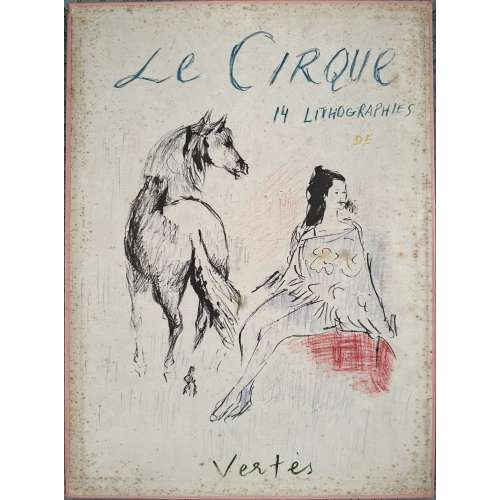 Publisher’s peach cloth box 555 x 410 mm with coloured lithograph on the lid, autographed with crayons "Le Cirque | 14 LITHOGRAPHIES | DE | {vignette} | Vertes"; in-folio unbound 4 pp. booklet on laid paper watermarked “Marais” and 14 loose leaves of plates on laid paper 520 x 395 mm without a watermark with coloured lithographs signed “Vertes” and numbered “195/250” in pencil; interleaved with tracing paper. Box and plates foxed. Title-page (red and black): LE | CIRQUE | 14 LITHOGRAPHIES DE | VERTÈS | PRÉSENTÉ | PAR | JEAN COCTEAU || Imprint: LES LIVES MERVEILLEUX | MONACO | Il a été tiré de cet album : | 150 Exemplaires, | destinés à | l'Amérique, | distribués bar les soins de | Arthur H. Harlow | de New-York, | & | 100 Exemplaires, | réservés à la France. | 15 Avril 1949 || Limitation: Edition limited to 250 copies (150 for USA, 100 for France); this is copy № 195 printed for France as the American copies marked “Published by Arthur H. Harlow & Co., New York. Seller’s Description: VERTÈS, Marcel (Hungarian-French, 1895-1961). Le Cirque 14 Lithographies de Vertès. Présénte par Jean Cocteau. [Monaco: Les Livres Merveilleux, 1949]. [vi] pp. With all 14 lithographs, each signed by the artist and numbered “195/250”. Text and lithographs 15 ¼ x 20 ½”. In original publisher’s peach cloth box with printed label on lid (box foxed, soiled, lightly worn; lithographs and text foxed). Still, a very good example of this lovely collection, with an introduction by Jean Cocteau (1889-1963). Catalogue Raisonné: Vokaer № 50. Marcel Vertès [Marcell Vértes] (Jewish-Hungarian-French, 1895 – 1961) – artist. Arthur H. Harlow (American, c. 1877 – 1958) – publisher. Jean Cocteau (French, 1889 – 1963) – author.
Publisher’s peach cloth box 555 x 410 mm with coloured lithograph on the lid, autographed with crayons "Le Cirque | 14 LITHOGRAPHIES | DE | {vignette} | Vertes"; in-folio unbound 4 pp. booklet on laid paper watermarked “Marais” and 14 loose leaves of plates on laid paper 520 x 395 mm without a watermark with coloured lithographs signed “Vertes” and numbered “195/250” in pencil; interleaved with tracing paper. Box and plates foxed. Title-page (red and black): LE | CIRQUE | 14 LITHOGRAPHIES DE | VERTÈS | PRÉSENTÉ | PAR | JEAN COCTEAU || Imprint: LES LIVES MERVEILLEUX | MONACO | Il a été tiré de cet album : | 150 Exemplaires, | destinés à | l'Amérique, | distribués bar les soins de | Arthur H. Harlow | de New-York, | & | 100 Exemplaires, | réservés à la France. | 15 Avril 1949 || Limitation: Edition limited to 250 copies (150 for USA, 100 for France); this is copy № 195 printed for France as the American copies marked “Published by Arthur H. Harlow & Co., New York. Seller’s Description: VERTÈS, Marcel (Hungarian-French, 1895-1961). Le Cirque 14 Lithographies de Vertès. Présénte par Jean Cocteau. [Monaco: Les Livres Merveilleux, 1949]. [vi] pp. With all 14 lithographs, each signed by the artist and numbered “195/250”. Text and lithographs 15 ¼ x 20 ½”. In original publisher’s peach cloth box with printed label on lid (box foxed, soiled, lightly worn; lithographs and text foxed). Still, a very good example of this lovely collection, with an introduction by Jean Cocteau (1889-1963). Catalogue Raisonné: Vokaer № 50. Marcel Vertès [Marcell Vértes] (Jewish-Hungarian-French, 1895 – 1961) – artist. Arthur H. Harlow (American, c. 1877 – 1958) – publisher. Jean Cocteau (French, 1889 – 1963) – author. -
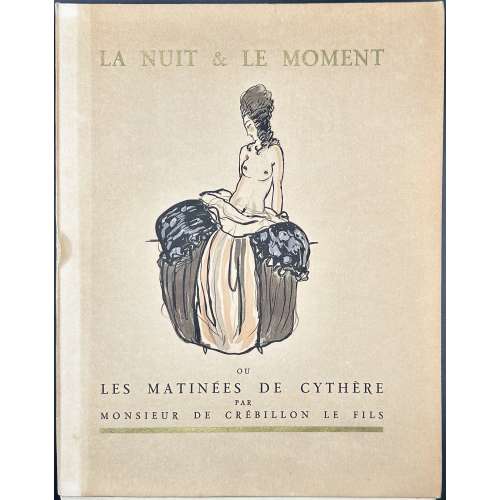 Softcover volume, 33 x 26 cm, collated in folio, not bound, in publisher’s French flapped pictorial wrappers, lettering to spine; printed on thick wove Arches paper watermarked “MBM”, upper edge trimmed, owner’s blind stamp to h.t. “Ex Libris Comte Tony de Vibraye”, glassine dust jacket, in a slipcase. Collation: π2 1-262, total 54 leaves, plus 4 leaves in wrappers, plus 10 plates, incl. frontispiece; coloured aquatints after Sylvain Sauvage; coloured etched vignette to front wrapper, gilt woodcut to back wrapper, woodcut title-page and woodcut headpiece after the same. Pp.: [4] [1] 2-102 [2]. Front wrapper (gilt and black): LA NUIT & LE MOMENT | {vignette} | OU | LES MATINÉES DE CYTHÈRE | PAR | MONSIEUR DE CRÉBILLON LE FILS | — || Title-page (woodcut): CRÉBILLON LE FILS | — | LA NUIT ET LE MOMENT | OU | LES MATINÉES | DE CYTHÈRE | {vignette} | A PARIS | AUX DEPENS D'UN AMATEUR | — | M CM XXIV || Limitation: De cette édition il a été tiré un exemplaire unique sur japon impérial comportant dix aquarelles originales, deux cents trente exemplaires sur vélin d' Arches numérotés 1 à 230, dont les dix premiers avec une suite de hors texte sur japon. N° 1 [Print run limited to 230 copies on Arches plus a unique copy on Japon with original watercolours, this is copy № 1 on wove paper]. Seller’s description: La Nuit et le moment ou Les Matinées de Cythère. Paris, Au dépens d'un amateur, 1924. In-4, en feuilles, non rogné, couverture illustrée et étui. Ouvrage illustré de 4 gravures sur bois et de 10 eaux-fortes libres en couleurs hors texte de Sylvain Sauvage. Tirage à 231 exemplaires, celui-ci le n°1 sur vélin d'Arches. Manque la suite de hors texte sur japon. De la bibliothèque du Comte Tony de Vibraye, avec cachet à froid. Dutel, n°2062. Catalogue raisonné: honesterotica.com; Dutel III 2062. Contributors: Claude-Prosper Jolyot de Crébillon [Crébillon fils] (French, 1707 – 1777) – author. Sylvain Sauvage [Félix Roy] (French, 1888 – 1948) – artist. Provenance: Antoine Henri Gaston Hurault de Vibraye [Comte Tony de Vibraye] (French, 1893 – 1951)
Softcover volume, 33 x 26 cm, collated in folio, not bound, in publisher’s French flapped pictorial wrappers, lettering to spine; printed on thick wove Arches paper watermarked “MBM”, upper edge trimmed, owner’s blind stamp to h.t. “Ex Libris Comte Tony de Vibraye”, glassine dust jacket, in a slipcase. Collation: π2 1-262, total 54 leaves, plus 4 leaves in wrappers, plus 10 plates, incl. frontispiece; coloured aquatints after Sylvain Sauvage; coloured etched vignette to front wrapper, gilt woodcut to back wrapper, woodcut title-page and woodcut headpiece after the same. Pp.: [4] [1] 2-102 [2]. Front wrapper (gilt and black): LA NUIT & LE MOMENT | {vignette} | OU | LES MATINÉES DE CYTHÈRE | PAR | MONSIEUR DE CRÉBILLON LE FILS | — || Title-page (woodcut): CRÉBILLON LE FILS | — | LA NUIT ET LE MOMENT | OU | LES MATINÉES | DE CYTHÈRE | {vignette} | A PARIS | AUX DEPENS D'UN AMATEUR | — | M CM XXIV || Limitation: De cette édition il a été tiré un exemplaire unique sur japon impérial comportant dix aquarelles originales, deux cents trente exemplaires sur vélin d' Arches numérotés 1 à 230, dont les dix premiers avec une suite de hors texte sur japon. N° 1 [Print run limited to 230 copies on Arches plus a unique copy on Japon with original watercolours, this is copy № 1 on wove paper]. Seller’s description: La Nuit et le moment ou Les Matinées de Cythère. Paris, Au dépens d'un amateur, 1924. In-4, en feuilles, non rogné, couverture illustrée et étui. Ouvrage illustré de 4 gravures sur bois et de 10 eaux-fortes libres en couleurs hors texte de Sylvain Sauvage. Tirage à 231 exemplaires, celui-ci le n°1 sur vélin d'Arches. Manque la suite de hors texte sur japon. De la bibliothèque du Comte Tony de Vibraye, avec cachet à froid. Dutel, n°2062. Catalogue raisonné: honesterotica.com; Dutel III 2062. Contributors: Claude-Prosper Jolyot de Crébillon [Crébillon fils] (French, 1707 – 1777) – author. Sylvain Sauvage [Félix Roy] (French, 1888 – 1948) – artist. Provenance: Antoine Henri Gaston Hurault de Vibraye [Comte Tony de Vibraye] (French, 1893 – 1951) -
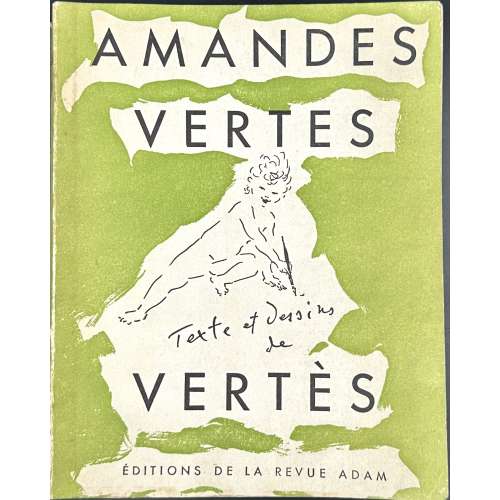 Paperback, 23.7 x 19 cm, green pictorial wrappers, lettering to spine, glassine dust jacket, some pages uncut, signed autograph blue ink inscription to h.t. "Au dr. Manuel Bruker en souvenir d'une harmonieuse collaboration. Vertès, 1952"; pp.[1-6] 7-489 [490] [2], profusely illustrated in b/w., Title-page: AMANDES VERTES | {vignette} | Texte et dessins | de | VERTÈS | ÉDITIONS REVUE ADAM | 4, RUE DE LA PAIX – PARIS – 2e || Limitation: Il a été tiré 200 exemplaires sur papier vélin d'arches; ceux-ci comportent un frontispice inédit en lithographie originale en 3 couleurs signée par l'auteur, tirée par Mourlot frères; ces exemplaires composent l'édition de luxe numérotée de 1 a 200. En plus, 20 exemplaires hors commence ont été réservés a des service personnels; ils sont numérotés de I a XX en chiffres romains. Ces deux éditions forment la totalité du tirage de luxe. Colophon: Achevé d'imprimer le 30 juin 1952 sur les presses de l'imprimerie Hérissey à Évreux numéro d'édition de l'éditeur : 91. Edition limited to 200 copies numbered 1 to 200 and 20 copies numbered from I to XX. This is copy № 91. No coloured frontispiece. Catalogue raisonné: Vokaer № 53. Provenance: Manuel Bruker (French, 1891 – 1979) Contributors: Marcel Vertès [Marcell Vértes] (Jewish-Hungarian-French, 1895 – 1961) – author/artist. Imprimerie Hérissey (Évreux) – printer. Edition Adam La Revue D' Homme [Revue Adam] – publisher.
Paperback, 23.7 x 19 cm, green pictorial wrappers, lettering to spine, glassine dust jacket, some pages uncut, signed autograph blue ink inscription to h.t. "Au dr. Manuel Bruker en souvenir d'une harmonieuse collaboration. Vertès, 1952"; pp.[1-6] 7-489 [490] [2], profusely illustrated in b/w., Title-page: AMANDES VERTES | {vignette} | Texte et dessins | de | VERTÈS | ÉDITIONS REVUE ADAM | 4, RUE DE LA PAIX – PARIS – 2e || Limitation: Il a été tiré 200 exemplaires sur papier vélin d'arches; ceux-ci comportent un frontispice inédit en lithographie originale en 3 couleurs signée par l'auteur, tirée par Mourlot frères; ces exemplaires composent l'édition de luxe numérotée de 1 a 200. En plus, 20 exemplaires hors commence ont été réservés a des service personnels; ils sont numérotés de I a XX en chiffres romains. Ces deux éditions forment la totalité du tirage de luxe. Colophon: Achevé d'imprimer le 30 juin 1952 sur les presses de l'imprimerie Hérissey à Évreux numéro d'édition de l'éditeur : 91. Edition limited to 200 copies numbered 1 to 200 and 20 copies numbered from I to XX. This is copy № 91. No coloured frontispiece. Catalogue raisonné: Vokaer № 53. Provenance: Manuel Bruker (French, 1891 – 1979) Contributors: Marcel Vertès [Marcell Vértes] (Jewish-Hungarian-French, 1895 – 1961) – author/artist. Imprimerie Hérissey (Évreux) – printer. Edition Adam La Revue D' Homme [Revue Adam] – publisher. -
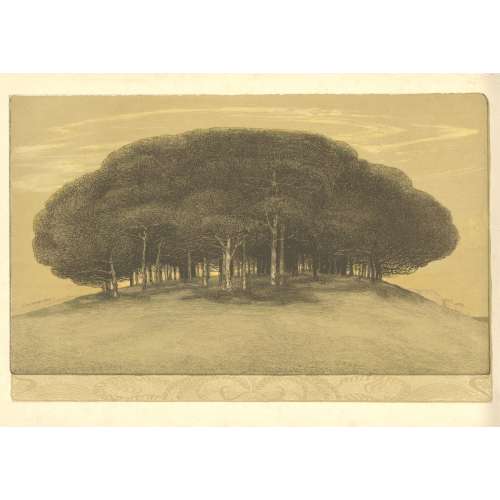 Colour (tone) lithography, image 268 x 410 mm, sheet 317 x 470 mm; signed on bottom-left of the image “Pelikan 1905”, and pencil ms inscription: E. Pelikan to the lower-right corner of the sheet. Contributor: Emilie Mediz-Pelikan (Austrian, 1861 – 1908) – artist. Seller's description: Austrian-German painter and graphic artist. Emilie Mediz-Pelikan was born in Vöcklabruck in 1861. She studied at the Vienna Academy and followed her teacher Albert Zimmermann to Salzburg and in 1885 to Munich. In 1891 she married the painter and graphic artist Karl Mediz (1868 - 1945), with whom she lived in Vienna and from 1894 in Dresden. She was in contact with the Dachau Artists' Colony and went on study trips to Paris, Belgium, Hungary and Italy. In the Dachau artists' colony she was friends with Adolf Hölzel and Fritz von Uhde. In 1889 and 1890 she spent time in Paris and in the Belgian artists' colony Knokke. In 1898 she was represented at the first art exhibition of the Vienna Secession, and in 1901 at the International Art Exhibition in Dresden. In 1903 she and her husband had a group exhibition, at the Hagenbund in Vienna. In 1904, she showed graphic works at the Dresden royal court art dealer Richter, and in 1905 and 1906 she exhibited at the Berlin Künstlerhaus. It was not until around 1900 that she achieved her artistic breakthrough with her landscape paintings. Since the estate of the artist, who died prematurely in Dresden in 1908, was lost in the former GDR until the 1980s, it was quite late that the artist was rediscovered and revalued both in Austrian art history and on the art market. In 1986, the first major exhibitions took place at the Upper Austrian State Museum and the University of Applied Arts in Vienna, followed by numerous smaller exhibitions in private galleries in Vienna, Linz and Munich. The artist received recognition during her lifetime from numerous prominent fellow painters as well as from the art critic Ludwig Hevesi. Together with Tina Blau, Herbert Boeckl, Marie Egner, Theodor von Hörmann, Franz Jaschke, Eugen Jettel, Ludwig Heinrich Jungnickel, Rudolf Junk, Gustav Klimt, Oskar Kokoschka, Johann Victor Krämer, Heinrich Kühn, Carl Moll, Rudolf Quittner, Rudolf Ribarz, Emil Jakob Schindler, Max Suppantschitsch, Max Weiler, Olga Wisinger-Florian and Alfred Zoff, she was a protagonist of the reception of Impressionism in Austria. This style went down in Austrian art history under the term "Stimmungsimpressionismus".
Colour (tone) lithography, image 268 x 410 mm, sheet 317 x 470 mm; signed on bottom-left of the image “Pelikan 1905”, and pencil ms inscription: E. Pelikan to the lower-right corner of the sheet. Contributor: Emilie Mediz-Pelikan (Austrian, 1861 – 1908) – artist. Seller's description: Austrian-German painter and graphic artist. Emilie Mediz-Pelikan was born in Vöcklabruck in 1861. She studied at the Vienna Academy and followed her teacher Albert Zimmermann to Salzburg and in 1885 to Munich. In 1891 she married the painter and graphic artist Karl Mediz (1868 - 1945), with whom she lived in Vienna and from 1894 in Dresden. She was in contact with the Dachau Artists' Colony and went on study trips to Paris, Belgium, Hungary and Italy. In the Dachau artists' colony she was friends with Adolf Hölzel and Fritz von Uhde. In 1889 and 1890 she spent time in Paris and in the Belgian artists' colony Knokke. In 1898 she was represented at the first art exhibition of the Vienna Secession, and in 1901 at the International Art Exhibition in Dresden. In 1903 she and her husband had a group exhibition, at the Hagenbund in Vienna. In 1904, she showed graphic works at the Dresden royal court art dealer Richter, and in 1905 and 1906 she exhibited at the Berlin Künstlerhaus. It was not until around 1900 that she achieved her artistic breakthrough with her landscape paintings. Since the estate of the artist, who died prematurely in Dresden in 1908, was lost in the former GDR until the 1980s, it was quite late that the artist was rediscovered and revalued both in Austrian art history and on the art market. In 1986, the first major exhibitions took place at the Upper Austrian State Museum and the University of Applied Arts in Vienna, followed by numerous smaller exhibitions in private galleries in Vienna, Linz and Munich. The artist received recognition during her lifetime from numerous prominent fellow painters as well as from the art critic Ludwig Hevesi. Together with Tina Blau, Herbert Boeckl, Marie Egner, Theodor von Hörmann, Franz Jaschke, Eugen Jettel, Ludwig Heinrich Jungnickel, Rudolf Junk, Gustav Klimt, Oskar Kokoschka, Johann Victor Krämer, Heinrich Kühn, Carl Moll, Rudolf Quittner, Rudolf Ribarz, Emil Jakob Schindler, Max Suppantschitsch, Max Weiler, Olga Wisinger-Florian and Alfred Zoff, she was a protagonist of the reception of Impressionism in Austria. This style went down in Austrian art history under the term "Stimmungsimpressionismus". -
 Colour (tone) lithography, image 396 x 508 mm, sheet 532 x 654 mm; before signature, undated; pencil ms inscription: Föhrenhain — E. Pelikan / 200M to the lower-right corner of the sheet. Contributor: Emilie Mediz-Pelikan (Austrian, 1861 – 1908) – artist. Seller's description: Austrian-German painter and graphic artist. Emilie Mediz-Pelikan was born in Vöcklabruck in 1861. She studied at the Vienna Academy and followed her teacher Albert Zimmermann to Salzburg and in 1885 to Munich. In 1891 she married the painter and graphic artist Karl Mediz (1868 - 1945), with whom she lived in Vienna and from 1894 in Dresden. She was in contact with the Dachau Artists' Colony and went on study trips to Paris, Belgium, Hungary and Italy. In the Dachau artists' colony she was friends with Adolf Hölzel and Fritz von Uhde. In 1889 and 1890 she spent time in Paris and in the Belgian artists' colony Knokke. In 1898 she was represented at the first art exhibition of the Vienna Secession, and in 1901 at the International Art Exhibition in Dresden. In 1903 she and her husband had a group exhibition, at the Hagenbund in Vienna. In 1904, she showed graphic works at the Dresden royal court art dealer Richter, and in 1905 and 1906 she exhibited at the Berlin Künstlerhaus. It was not until around 1900 that she achieved her artistic breakthrough with her landscape paintings. Since the estate of the artist, who died prematurely in Dresden in 1908, was lost in the former GDR until the 1980s, it was quite late that the artist was rediscovered and revalued both in Austrian art history and on the art market. In 1986, the first major exhibitions took place at the Upper Austrian State Museum and the University of Applied Arts in Vienna, followed by numerous smaller exhibitions in private galleries in Vienna, Linz and Munich. The artist received recognition during her lifetime from numerous prominent fellow painters as well as from the art critic Ludwig Hevesi. Together with Tina Blau, Herbert Boeckl, Marie Egner, Theodor von Hörmann, Franz Jaschke, Eugen Jettel, Ludwig Heinrich Jungnickel, Rudolf Junk, Gustav Klimt, Oskar Kokoschka, Johann Victor Krämer, Heinrich Kühn, Carl Moll, Rudolf Quittner, Rudolf Ribarz, Emil Jakob Schindler, Max Suppantschitsch, Max Weiler, Olga Wisinger-Florian and Alfred Zoff, she was a protagonist of the reception of Impressionism in Austria. This style went down in Austrian art history under the term "Stimmungsimpressionismus".
Colour (tone) lithography, image 396 x 508 mm, sheet 532 x 654 mm; before signature, undated; pencil ms inscription: Föhrenhain — E. Pelikan / 200M to the lower-right corner of the sheet. Contributor: Emilie Mediz-Pelikan (Austrian, 1861 – 1908) – artist. Seller's description: Austrian-German painter and graphic artist. Emilie Mediz-Pelikan was born in Vöcklabruck in 1861. She studied at the Vienna Academy and followed her teacher Albert Zimmermann to Salzburg and in 1885 to Munich. In 1891 she married the painter and graphic artist Karl Mediz (1868 - 1945), with whom she lived in Vienna and from 1894 in Dresden. She was in contact with the Dachau Artists' Colony and went on study trips to Paris, Belgium, Hungary and Italy. In the Dachau artists' colony she was friends with Adolf Hölzel and Fritz von Uhde. In 1889 and 1890 she spent time in Paris and in the Belgian artists' colony Knokke. In 1898 she was represented at the first art exhibition of the Vienna Secession, and in 1901 at the International Art Exhibition in Dresden. In 1903 she and her husband had a group exhibition, at the Hagenbund in Vienna. In 1904, she showed graphic works at the Dresden royal court art dealer Richter, and in 1905 and 1906 she exhibited at the Berlin Künstlerhaus. It was not until around 1900 that she achieved her artistic breakthrough with her landscape paintings. Since the estate of the artist, who died prematurely in Dresden in 1908, was lost in the former GDR until the 1980s, it was quite late that the artist was rediscovered and revalued both in Austrian art history and on the art market. In 1986, the first major exhibitions took place at the Upper Austrian State Museum and the University of Applied Arts in Vienna, followed by numerous smaller exhibitions in private galleries in Vienna, Linz and Munich. The artist received recognition during her lifetime from numerous prominent fellow painters as well as from the art critic Ludwig Hevesi. Together with Tina Blau, Herbert Boeckl, Marie Egner, Theodor von Hörmann, Franz Jaschke, Eugen Jettel, Ludwig Heinrich Jungnickel, Rudolf Junk, Gustav Klimt, Oskar Kokoschka, Johann Victor Krämer, Heinrich Kühn, Carl Moll, Rudolf Quittner, Rudolf Ribarz, Emil Jakob Schindler, Max Suppantschitsch, Max Weiler, Olga Wisinger-Florian and Alfred Zoff, she was a protagonist of the reception of Impressionism in Austria. This style went down in Austrian art history under the term "Stimmungsimpressionismus". -
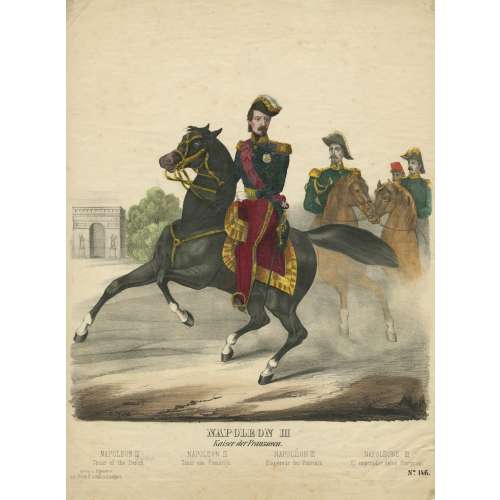 Hand-coloured lithography on wove paper 423 x 332 mm; On reverse: black ink stamp “4956”, ms “A”, ms pencil “428” and “Ernest”. Under the image, centre: "NAPOLEON III | Kaiser der Franzosen." Velow: | NAPOLEON III | Czaar of the French — NAPOLEON III | Czaar van Frankrijk — NAPOLÉON III | Empereur des Francais. — NAPOLEONE III | El emperador delos Franceses; bottom left: "Verlag u. Eigenthum | von. Fried. G. Schulz in Stuttgart.", right: "No 146." The artist's and printer's names in stone are not legible. Published in Stuttgart by Friederich Gustav Schulz (German, 1786 – 1859) during the time of the Second French Empire (1852-1870).
Hand-coloured lithography on wove paper 423 x 332 mm; On reverse: black ink stamp “4956”, ms “A”, ms pencil “428” and “Ernest”. Under the image, centre: "NAPOLEON III | Kaiser der Franzosen." Velow: | NAPOLEON III | Czaar of the French — NAPOLEON III | Czaar van Frankrijk — NAPOLÉON III | Empereur des Francais. — NAPOLEONE III | El emperador delos Franceses; bottom left: "Verlag u. Eigenthum | von. Fried. G. Schulz in Stuttgart.", right: "No 146." The artist's and printer's names in stone are not legible. Published in Stuttgart by Friederich Gustav Schulz (German, 1786 – 1859) during the time of the Second French Empire (1852-1870). -
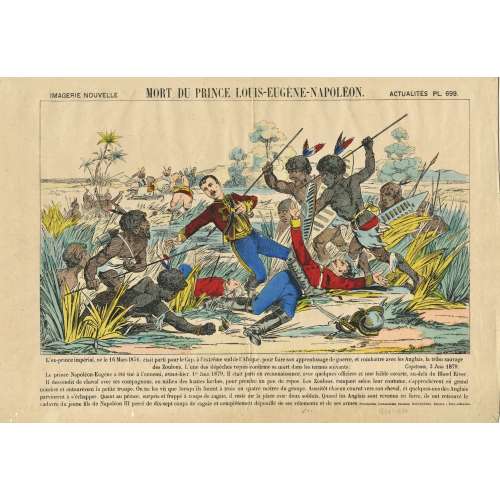 Hand-coloured lithography on wove paper, 275 x 385 mm; vertical centerfold, image in frame. On reverse: black ink stamp “5350”. Above the frame: "IMAGERIE NOUVELLE — MORT DU PRINCE LOUIS-EUGÈNE-NAPOLÉON. — ACTUALITÉS PL. 699". Under the frame: "L'ex-prince impérial, né le 16 Mars I856, était parti pour le Cap, à l'extrême sud de l'Afrique, pour faire son apprentissage de guerre, et combattre avec les Anglais, la tribu sauvage des Zoulous. L'une des dépêches reçues confirme sa mort dans les termes suivants: — Capetown, 3 Juin 1879. — Le prince Napoléon-Eugène a été tué à l'ennemi, avant-hier, 1er Juin 1879, Il était parti en reconnaissance, avec quelques officiers et une fable escorte, au-delà du Blood River. Il descendit de cheval ave ses compagnons, au milieu des hautes herbes, pour prendre un peu de repos. Les Zoulous, rampant selon leur coutume, s'approchèrent en grand nombre et entourèrent la petite troupe. On ne les vit que lorsqu' ils furent à trois ou quatre mètres du groupe. Aussitôt chacun court vers son cheval, et quelques-uns des Anglais parvinrent à s'échapper. Quant au prince, surpris et frappé à coups de zagaie, il resta sur la place avec deux soldats. Quand les Anglais sont revenus en force, ils ont retrouvé le cadavre du jeune fils de Napoléon III percé de dix-sept coups de zagaie et complétement dépouillé de ses vêtements et de ses armes". — "Typographie, Lithographie, Imagerie, Haguenthal, Éditeur à Pont-à-Mousson". Pencil ms: "1860-1880". Élie Haguenthal (French, 1822 – 1881) – publisher/printer.
Hand-coloured lithography on wove paper, 275 x 385 mm; vertical centerfold, image in frame. On reverse: black ink stamp “5350”. Above the frame: "IMAGERIE NOUVELLE — MORT DU PRINCE LOUIS-EUGÈNE-NAPOLÉON. — ACTUALITÉS PL. 699". Under the frame: "L'ex-prince impérial, né le 16 Mars I856, était parti pour le Cap, à l'extrême sud de l'Afrique, pour faire son apprentissage de guerre, et combattre avec les Anglais, la tribu sauvage des Zoulous. L'une des dépêches reçues confirme sa mort dans les termes suivants: — Capetown, 3 Juin 1879. — Le prince Napoléon-Eugène a été tué à l'ennemi, avant-hier, 1er Juin 1879, Il était parti en reconnaissance, avec quelques officiers et une fable escorte, au-delà du Blood River. Il descendit de cheval ave ses compagnons, au milieu des hautes herbes, pour prendre un peu de repos. Les Zoulous, rampant selon leur coutume, s'approchèrent en grand nombre et entourèrent la petite troupe. On ne les vit que lorsqu' ils furent à trois ou quatre mètres du groupe. Aussitôt chacun court vers son cheval, et quelques-uns des Anglais parvinrent à s'échapper. Quant au prince, surpris et frappé à coups de zagaie, il resta sur la place avec deux soldats. Quand les Anglais sont revenus en force, ils ont retrouvé le cadavre du jeune fils de Napoléon III percé de dix-sept coups de zagaie et complétement dépouillé de ses vêtements et de ses armes". — "Typographie, Lithographie, Imagerie, Haguenthal, Éditeur à Pont-à-Mousson". Pencil ms: "1860-1880". Élie Haguenthal (French, 1822 – 1881) – publisher/printer. -
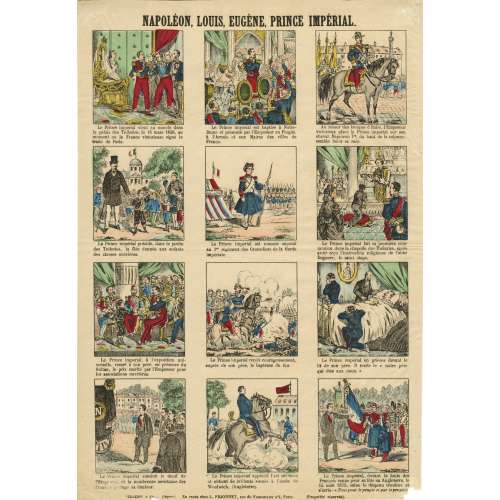 Hand-coloured woodcut on wove paper, 400 x 277 mm. Top: "NAPOLÉON, LOUIS, EUGÈNE, PRINCE IMPÉRIAL"; bellow 12 captioned frames:
Hand-coloured woodcut on wove paper, 400 x 277 mm. Top: "NAPOLÉON, LOUIS, EUGÈNE, PRINCE IMPÉRIAL"; bellow 12 captioned frames:- Le Prince impérial vient au monde dans le palais des Tuileries, le 16 mars 1856, au moment où la France victorieuse signe le traité de Paris.
- Le Prince impérial est baptisé à Notre-Dame et présenté par l'Empereur au Peuple, à l’Armée et aux Maires des villes de France.
- Au retour des troupes d'Italie, l'Empereur victorieux place le Prince impérial sur son cheval. Napoléon Ier, du haut de la colonne, semble bénir sa race.
- Le Prince impérial préside, dans le jardin des Tuileries, la fête donnée aux enfants des classes ouvrières.
- Le Prince impérial est nommé caporal au 1er régiment des Grenadiers de la Garde impériale.
- Le Prince impérial fait sa première communion dans la chapelle des Tuileries, après avoir reçu l'instruction religieuse de l'abbé Deguerry, le saint otage.
- Le Prince impérial, à l'exposition universelle, remet à son père. en présence du Sultan, le prix mérité par l'Empereur pour les associations ouvrières.
- Le Prince impérial reçoit courageusement, auprès de son père, le baptême du feu.
- Le Prince impérial en prières devant le lit de son père. Il récite le « notre père qui ètes aux cieux. »
- Le Prince impérial conduit le deuil de l'Empereur, et la nombreuse assistance des Français portage sa douleur.
- Le Prince impérial apprend l’art militaire et obtient de brillants succès à l'écolo de Woolwich, (Angleterre).
- Le Prince impérial, devant la foule des Français venus pour sa fête en Angleterre, le 15 out 1873, salue le drapeau tricolore et s'écrie : « Tout pour le peuple et par le peuple… »
-
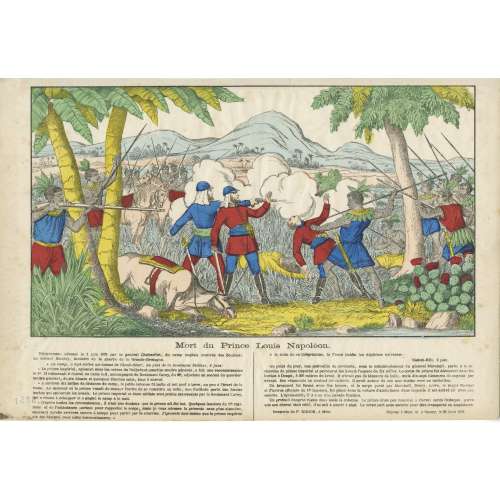 Hand-coloured woodcut on wove paper, 267 x 390 mm. On reverse: black ink stamp “5351”. Centre, under the image frame "Mort du Prince Louis Napoléon". Below left: "Télégramme adressé le 2 juin 1879 par le général Chelmsfort, du camp anglais (contrée des Zoulous), au colonel Stanley, ministre de la guerre de la Grande-Bretagne. « Au camp, à sept milles au-dessus de Blood-River, au pied de la montagne Stellezi, 2 juin: Le prince impérial, agissant sous les ordres de l'adjudant quartier-maitre général. a fait une reconnaissance le 1er. Il retournait à cheval au camp le 2 accompagné du lieutenant Carey, du 98e adjudant en second du quartier-maitre général. de six blancs et, quelques Zoulous amis, tous à cheval. A environ dix milles de distance du camp, la petite colonne fit halte at mit pied à terre, un peu à l’écart de la route. Au moment ou le prince venait de donner l'ordre de se remettre en selle. une fusillade partit des hautes herbes qui entourant les kraals. Le prince impérial et deux soldats sont portés manquants par le lieutenant Carey, qui a réussi à échapper et a gagné le camp à la nuit. D'après toutes les circonstances, il 'est pas douteux quo le prince ait été tué. Quelques lanciers du 17 régiment et de l'ambulance partent pour rapporter le corps; mais je vous adresse la présente sans plus attendre, espérant qu'elle arrivera encore à temps pour partir par le courrier. J’ignorais moi-même que le prince impérial eût été désigné pour cette reconnaissance. »" Below right: A la suite de le télégramme, le Times publie les dépêches suivantes: Stelezi-Hill, 2 juin. Au point du jour, une patrouille de cavalerie, sous le commandement du général Marshall. partit à la recherche du prince impérial et parcourut les kraals l'espace de dix milles. Le corps du prince fut découvert dans les herbes à Donga, à 300 mètres du kraal. Il n'avait pas de blessure de balle, mais dix-sept blessures de zagaies par devant. Ses vêtements lui avaient été enlevés. I avait autour du cou une chaine avec un médaillon. Un brancard fut formé avec les lances, et le corps porté par Marchall, Drury, Lowe, le mjor Stewart et d'autres officiers du 17e lanciers, fut. place dans la voiture d'ambulance dans laquelle il est arrivé ici avec une escorte. L'après-midi, il v a eu une parade funèbre. Un profond chagrin règne dans toute la colonne. Le prince n'est pas remonté à cheval après l’attique, parce que son cheval était rétif ; il se mit à courir à pied. Le corps part sous escorte pour être transporté en Angleterre. Bottom right: "Imagerie de P. DIDION, à Metz — Déposé à Metz et à Nancy, le 25 Juin 1879". Paulin Didion (French, 1831 – 1879) – publisher/printer.
Hand-coloured woodcut on wove paper, 267 x 390 mm. On reverse: black ink stamp “5351”. Centre, under the image frame "Mort du Prince Louis Napoléon". Below left: "Télégramme adressé le 2 juin 1879 par le général Chelmsfort, du camp anglais (contrée des Zoulous), au colonel Stanley, ministre de la guerre de la Grande-Bretagne. « Au camp, à sept milles au-dessus de Blood-River, au pied de la montagne Stellezi, 2 juin: Le prince impérial, agissant sous les ordres de l'adjudant quartier-maitre général. a fait une reconnaissance le 1er. Il retournait à cheval au camp le 2 accompagné du lieutenant Carey, du 98e adjudant en second du quartier-maitre général. de six blancs et, quelques Zoulous amis, tous à cheval. A environ dix milles de distance du camp, la petite colonne fit halte at mit pied à terre, un peu à l’écart de la route. Au moment ou le prince venait de donner l'ordre de se remettre en selle. une fusillade partit des hautes herbes qui entourant les kraals. Le prince impérial et deux soldats sont portés manquants par le lieutenant Carey, qui a réussi à échapper et a gagné le camp à la nuit. D'après toutes les circonstances, il 'est pas douteux quo le prince ait été tué. Quelques lanciers du 17 régiment et de l'ambulance partent pour rapporter le corps; mais je vous adresse la présente sans plus attendre, espérant qu'elle arrivera encore à temps pour partir par le courrier. J’ignorais moi-même que le prince impérial eût été désigné pour cette reconnaissance. »" Below right: A la suite de le télégramme, le Times publie les dépêches suivantes: Stelezi-Hill, 2 juin. Au point du jour, une patrouille de cavalerie, sous le commandement du général Marshall. partit à la recherche du prince impérial et parcourut les kraals l'espace de dix milles. Le corps du prince fut découvert dans les herbes à Donga, à 300 mètres du kraal. Il n'avait pas de blessure de balle, mais dix-sept blessures de zagaies par devant. Ses vêtements lui avaient été enlevés. I avait autour du cou une chaine avec un médaillon. Un brancard fut formé avec les lances, et le corps porté par Marchall, Drury, Lowe, le mjor Stewart et d'autres officiers du 17e lanciers, fut. place dans la voiture d'ambulance dans laquelle il est arrivé ici avec une escorte. L'après-midi, il v a eu une parade funèbre. Un profond chagrin règne dans toute la colonne. Le prince n'est pas remonté à cheval après l’attique, parce que son cheval était rétif ; il se mit à courir à pied. Le corps part sous escorte pour être transporté en Angleterre. Bottom right: "Imagerie de P. DIDION, à Metz — Déposé à Metz et à Nancy, le 25 Juin 1879". Paulin Didion (French, 1831 – 1879) – publisher/printer. -
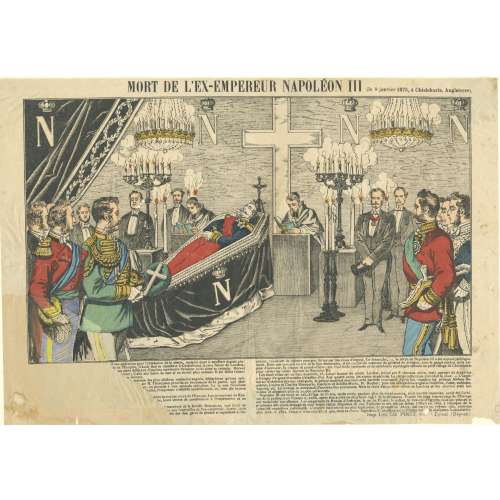 Hand-coloured woodcut on wove paper, 270 x 380 mm; attached to the sheet 303 x 442 mm with pencil ms inscription to the top left corner on the reverse: “Haye le 2-3-75”. Top: "MORT DE L'EX-EMPEREUR NAPOLÉON III (le 9 janvier 1873, à Chislehurts [sic], Angleterre)." Bottom right: "Imp. Lith. CH. PINOT, éditeur. Épinal (Dépose)". Bottom left corner of the image sheet torn and manually restored. Text partially lost, starting with « d’une opération pour l’extraction de la pierre, maladie dont’ il souffrait depuis plu-… ». See Chislehurst. Charles-François Pinot (French, 1817 – 1879) – publisher/printer.
Hand-coloured woodcut on wove paper, 270 x 380 mm; attached to the sheet 303 x 442 mm with pencil ms inscription to the top left corner on the reverse: “Haye le 2-3-75”. Top: "MORT DE L'EX-EMPEREUR NAPOLÉON III (le 9 janvier 1873, à Chislehurts [sic], Angleterre)." Bottom right: "Imp. Lith. CH. PINOT, éditeur. Épinal (Dépose)". Bottom left corner of the image sheet torn and manually restored. Text partially lost, starting with « d’une opération pour l’extraction de la pierre, maladie dont’ il souffrait depuis plu-… ». See Chislehurst. Charles-François Pinot (French, 1817 – 1879) – publisher/printer. -
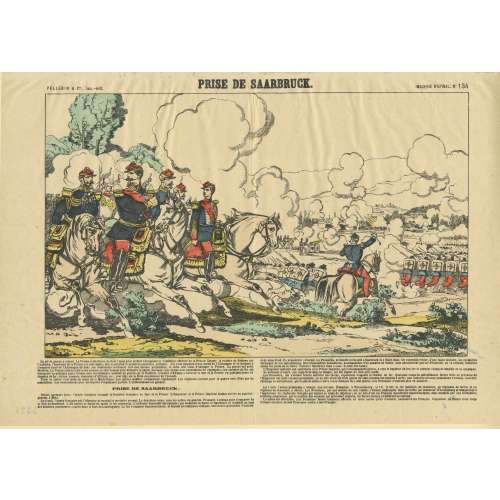 Hand-coloured woodcut on wove paper, 268 x 381 mm, vertical centerfold. On reverse: black ink stamp “5324”. Top centre: "PRISE DE SAARBRUCK"; left: "PELLERIN & Cie, imp. -édit."; right: "IMAGERIE D'EPINAL, № 134." Under the frame text starts with « La cri de guerre a retenti. La France a été forcée de tirer l’épée pour arrêter… ».[...] Prise de Saarbruck. | Depuis quelques jours, l’armée française occupait la frontière française en face de la Prusse.... Jean Charles Pellerin (French, 1756 – 1836) – publisher/printer. The Battle of Saarbrücken (2 August 1870).
Hand-coloured woodcut on wove paper, 268 x 381 mm, vertical centerfold. On reverse: black ink stamp “5324”. Top centre: "PRISE DE SAARBRUCK"; left: "PELLERIN & Cie, imp. -édit."; right: "IMAGERIE D'EPINAL, № 134." Under the frame text starts with « La cri de guerre a retenti. La France a été forcée de tirer l’épée pour arrêter… ».[...] Prise de Saarbruck. | Depuis quelques jours, l’armée française occupait la frontière française en face de la Prusse.... Jean Charles Pellerin (French, 1756 – 1836) – publisher/printer. The Battle of Saarbrücken (2 August 1870). -
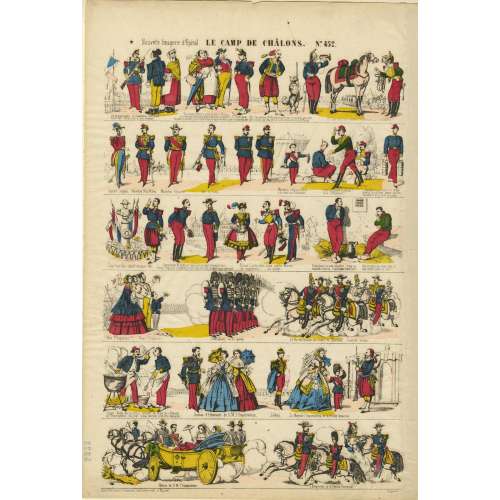 Hand-coloured woodcut on wove paper, 409 x 280 mm; black ink stamp “5323” to reverse; attached to the sheet 487 x 320 mm. Top centre: "LE CAMP DE CHALONS."; left: "Nouvelle Imagerre d'Epinal"; right: № 452. Bottom left: "Imp lith. Pinot & Sagaire, libraires edit. à Épinal"; right: "Déposé". Image: 6-tier cartoon with captions about Napoleon III and his son Prince Imperial (Napoléon Eugène Louis Jean Joseph Bonaparte; 16 March 1856 – 1 June 1879). Le camp de Chalons Pinot & Sagaire (Épinal, 1861 – 1888) – enterprise, publisher/printer. Charles-François Pinot (French, 1817 – 1879) – publisher/printer.
Hand-coloured woodcut on wove paper, 409 x 280 mm; black ink stamp “5323” to reverse; attached to the sheet 487 x 320 mm. Top centre: "LE CAMP DE CHALONS."; left: "Nouvelle Imagerre d'Epinal"; right: № 452. Bottom left: "Imp lith. Pinot & Sagaire, libraires edit. à Épinal"; right: "Déposé". Image: 6-tier cartoon with captions about Napoleon III and his son Prince Imperial (Napoléon Eugène Louis Jean Joseph Bonaparte; 16 March 1856 – 1 June 1879). Le camp de Chalons Pinot & Sagaire (Épinal, 1861 – 1888) – enterprise, publisher/printer. Charles-François Pinot (French, 1817 – 1879) – publisher/printer. -
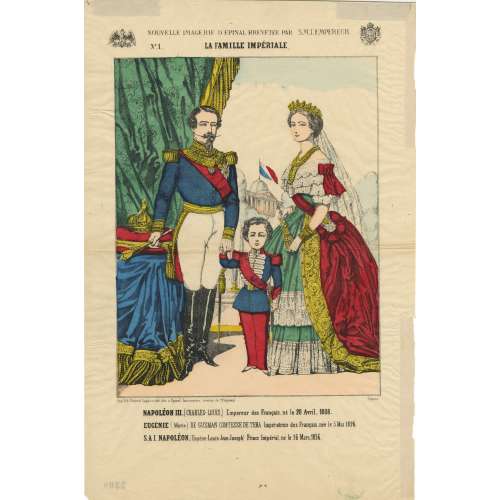 Hand-coloured woodcut on wove paper, 390 x 260 mm; black ink stamp “5308” to reverse; horizontal centerfold. Centre top: "NOUVELLE IMAGERIE D'ÉPINAL BREVETÉE PAR S.M.L’EMPEREUR" with imperial eagle and coat of arms at right and left. Below: "№ 1." — "LA FAMILLE IMPÉRIALE"; image in frame; under the image, left: "Imp lith. Pinot & Sagaire, édit. libr. à Épinal, fournisseurs brevetés de l’Empereur"; right: "Déposé". Bottom: "NAPOLÉON I. (CHARLES-LOUIS,) Empereur des Français, né le 20 Avril, 1808. | EUGÉNIE ( Marie) DE GUSMAN COMTESSE DE TEBA Impératrice des Français, née le 5 Mai 1826. | S.A I. NAPOLÉON. (Eugène-Louis-Jean-Joseph) Prince Impérial, ne le 16 Mars. 1856." Napoleon III [Charles-Louis Napoléon Bonaparte] (French, 1808 – 1873) Eugénie de Montijo [L'impératrice Eugénie] (Spanish-French, 1826 – 1920) Napoléon, Prince Imperial (Napoléon Eugène Louis Jean Joseph Bonaparte] (French, 1856 – 1879) Pinot & Sagaire (Épinal, 1861 – 1888) – enterprise, publisher/printer. Charles-François Pinot (French, 1817 – 1879) – publisher/printer.
Hand-coloured woodcut on wove paper, 390 x 260 mm; black ink stamp “5308” to reverse; horizontal centerfold. Centre top: "NOUVELLE IMAGERIE D'ÉPINAL BREVETÉE PAR S.M.L’EMPEREUR" with imperial eagle and coat of arms at right and left. Below: "№ 1." — "LA FAMILLE IMPÉRIALE"; image in frame; under the image, left: "Imp lith. Pinot & Sagaire, édit. libr. à Épinal, fournisseurs brevetés de l’Empereur"; right: "Déposé". Bottom: "NAPOLÉON I. (CHARLES-LOUIS,) Empereur des Français, né le 20 Avril, 1808. | EUGÉNIE ( Marie) DE GUSMAN COMTESSE DE TEBA Impératrice des Français, née le 5 Mai 1826. | S.A I. NAPOLÉON. (Eugène-Louis-Jean-Joseph) Prince Impérial, ne le 16 Mars. 1856." Napoleon III [Charles-Louis Napoléon Bonaparte] (French, 1808 – 1873) Eugénie de Montijo [L'impératrice Eugénie] (Spanish-French, 1826 – 1920) Napoléon, Prince Imperial (Napoléon Eugène Louis Jean Joseph Bonaparte] (French, 1856 – 1879) Pinot & Sagaire (Épinal, 1861 – 1888) – enterprise, publisher/printer. Charles-François Pinot (French, 1817 – 1879) – publisher/printer. -
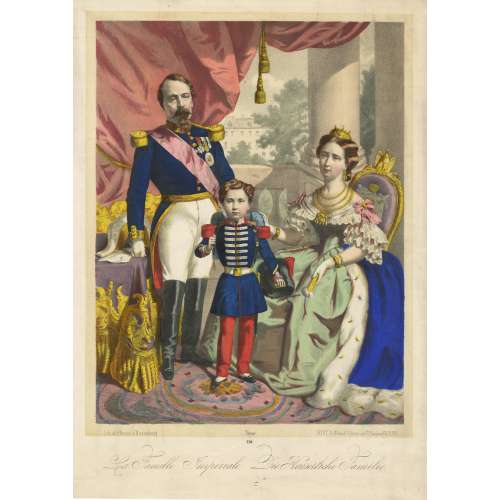 Hand-coloured lithography on wove paper, 395 x 280 mm; black ink stamp “5309” to reverse. On image: artist's initials "L. H."; on stone: "Lith. de Fr. Wentzel a Wissembourg. — Déposé — DÉPÔT, Fr. Wentzel Editeur rue St. Jacques 65, PARIS"; below centre: "239"; bottom : La famille Impériale. Die Kaizerliche Familie. Napoleon III [Charles-Louis Napoléon Bonaparte] (French, 1808 – 1873) Eugénie de Montijo [L'impératrice Eugénie] (Spanish-French, 1826 – 1920) Napoléon, Prince Imperial (Napoléon Eugène Louis Jean Joseph Bonaparte] (French, 1856 – 1879) Jean Frédéric Wentzel (French, 1807 – 1869) – publisher/printer.
Hand-coloured lithography on wove paper, 395 x 280 mm; black ink stamp “5309” to reverse. On image: artist's initials "L. H."; on stone: "Lith. de Fr. Wentzel a Wissembourg. — Déposé — DÉPÔT, Fr. Wentzel Editeur rue St. Jacques 65, PARIS"; below centre: "239"; bottom : La famille Impériale. Die Kaizerliche Familie. Napoleon III [Charles-Louis Napoléon Bonaparte] (French, 1808 – 1873) Eugénie de Montijo [L'impératrice Eugénie] (Spanish-French, 1826 – 1920) Napoléon, Prince Imperial (Napoléon Eugène Louis Jean Joseph Bonaparte] (French, 1856 – 1879) Jean Frédéric Wentzel (French, 1807 – 1869) – publisher/printer. -
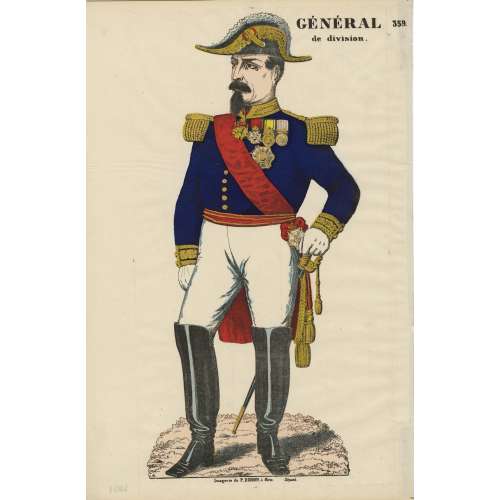 Hand-coloured woodcut on wove paper, 430 x 285 mm; black ink stamp “5051” to reverse. Top right: "GÉNÉRAL | de division." — "359." Bottom: "Imagerie de DIDION, à Metz. Déposé." Paulin Didion (French, 1831 – 1879) – publisher/printer.
Hand-coloured woodcut on wove paper, 430 x 285 mm; black ink stamp “5051” to reverse. Top right: "GÉNÉRAL | de division." — "359." Bottom: "Imagerie de DIDION, à Metz. Déposé." Paulin Didion (French, 1831 – 1879) – publisher/printer. -
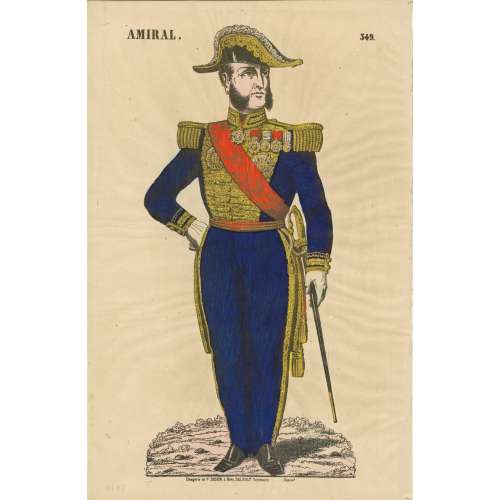 Hand-coloured woodcut on wove paper, 440 x 285 mm; black ink stamp “5049” to reverse. Top left: "AMIRAL"; right: "349". Below: "Imagerie de DIDION, à Metz, DELHALT Successeur." — "Déposé." Paulin Didion (French, 1831 – 1879) – publisher/printer.
Hand-coloured woodcut on wove paper, 440 x 285 mm; black ink stamp “5049” to reverse. Top left: "AMIRAL"; right: "349". Below: "Imagerie de DIDION, à Metz, DELHALT Successeur." — "Déposé." Paulin Didion (French, 1831 – 1879) – publisher/printer. -
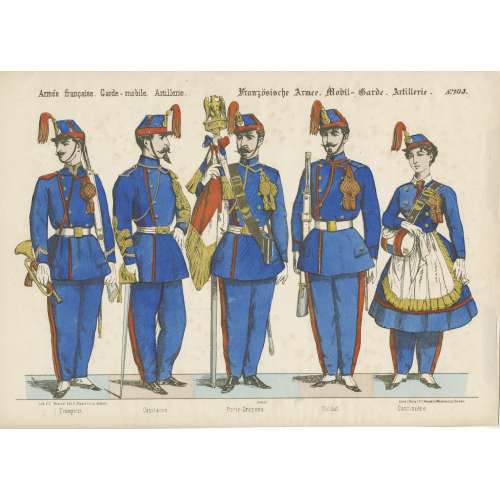 Hand-coloured woodcut on wove paper, 282 x 392 mm; black ink stamp “5051 2” to reverse. Top: "Armée française. Garde–mobile. Artillerie." — (gothic font) "Französische Armee. Mobil–Garde. Artillerie." — "№103". Below left: "Lith F. C. Wentzel édit. à Wissembourg. (Alsacé); center: Déposé; right: Druck u. Verlag v. F. C. Wentzel in Weissemburg. (Elsass)."; Bottom: "Trompette" — "Capitaine" — "Porte-Drapeau". — "Soldat" — "Cantinière." Jean Frédéric Wentzel (French, 1807 – 1869) – publisher/printer.
Hand-coloured woodcut on wove paper, 282 x 392 mm; black ink stamp “5051 2” to reverse. Top: "Armée française. Garde–mobile. Artillerie." — (gothic font) "Französische Armee. Mobil–Garde. Artillerie." — "№103". Below left: "Lith F. C. Wentzel édit. à Wissembourg. (Alsacé); center: Déposé; right: Druck u. Verlag v. F. C. Wentzel in Weissemburg. (Elsass)."; Bottom: "Trompette" — "Capitaine" — "Porte-Drapeau". — "Soldat" — "Cantinière." Jean Frédéric Wentzel (French, 1807 – 1869) – publisher/printer. -
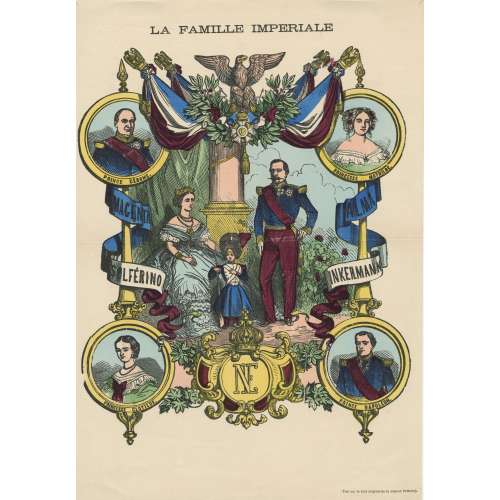 Hand-coloured woodcut on laid paper, 422 x 294 mm; black ink stamp “5307” to reverse, centrefold. Top center: "LA FAMILLE IMPERIALE"; Bottom right: "(Tire sur le bois original de maison Pellerin)". Image: Napoléon III, Empress Eugenie, and Prince Imperial Louis-Napoléon as a child surrounded with four lettered medallions: “PRINCE GÉROME”, “PRINCESSE MATHILDE”, “PRINCESSE CLOTILDE”, and “PRINCE NAPOLÉON”; ribbons lettered: “MAGENTA”, SOLFERINO”, “ALMA”, and “INKERMANN” around heraldic spears; coat of arms with imperial monogram between Princesse Clotilde and Prince Napoléon. Publisher/printer: Jean Charles Pellerin (French, 1756 – 1836). Battle of Magenta : 4 June 1859, against the Austrians. Battle of Solferino : 24 June 1859, against the Austrians. Battle of the Alma : 20 September 1854 (Crimean War) Battle of Inkerman : 5 November 1854 (Crimean War) Characters: Napoleon III [Charles-Louis Napoléon Bonaparte] (French, 1808 – 1873) Eugénie de Montijo [L'impératrice Eugénie] (Spanish-French, 1826 – 1920) Napoléon, Prince Imperial (Napoléon Eugène Louis Jean Joseph Bonaparte] (French, 1856 – 1879) Napoléon-Jérôme Bonaparte [Prince Jérôme] (French, 1822 – 1891) Mathilde Bonaparte [Princess Mathilde] (French, 1820 – 1904) Marie-Clotilde de Savoie [Princesse Clotilde] (French, 1843 – 1911)
Hand-coloured woodcut on laid paper, 422 x 294 mm; black ink stamp “5307” to reverse, centrefold. Top center: "LA FAMILLE IMPERIALE"; Bottom right: "(Tire sur le bois original de maison Pellerin)". Image: Napoléon III, Empress Eugenie, and Prince Imperial Louis-Napoléon as a child surrounded with four lettered medallions: “PRINCE GÉROME”, “PRINCESSE MATHILDE”, “PRINCESSE CLOTILDE”, and “PRINCE NAPOLÉON”; ribbons lettered: “MAGENTA”, SOLFERINO”, “ALMA”, and “INKERMANN” around heraldic spears; coat of arms with imperial monogram between Princesse Clotilde and Prince Napoléon. Publisher/printer: Jean Charles Pellerin (French, 1756 – 1836). Battle of Magenta : 4 June 1859, against the Austrians. Battle of Solferino : 24 June 1859, against the Austrians. Battle of the Alma : 20 September 1854 (Crimean War) Battle of Inkerman : 5 November 1854 (Crimean War) Characters: Napoleon III [Charles-Louis Napoléon Bonaparte] (French, 1808 – 1873) Eugénie de Montijo [L'impératrice Eugénie] (Spanish-French, 1826 – 1920) Napoléon, Prince Imperial (Napoléon Eugène Louis Jean Joseph Bonaparte] (French, 1856 – 1879) Napoléon-Jérôme Bonaparte [Prince Jérôme] (French, 1822 – 1891) Mathilde Bonaparte [Princess Mathilde] (French, 1820 – 1904) Marie-Clotilde de Savoie [Princesse Clotilde] (French, 1843 – 1911) -
 Hand-coloured woodcut on wove paper, 400 x 270 mm; black ink stamp “5306” to reverse. Top centre: "FAMILLE IMPÉRIALE", right: "62."; below centre: "Fabrique d'Images de GANGEL et P. DIDION, à Metz."; right: "Déposé." Publisher/printer: Gangel et P. Didion (Metz); Paulin Didion (French, 1831 – 1879). Characters: Napoleon III [Charles-Louis Napoléon Bonaparte] (French, 1808 – 1873) Eugénie de Montijo [L'impératrice Eugénie] (Spanish-French, 1826 – 1920) Napoléon, Prince Imperial (Napoléon Eugène Louis Jean Joseph Bonaparte] (French, 1856 – 1879) Napoléon II [Napoléon François Joseph Charles Bonaparte] (French, 1811 – 1832) Napoléon Ier [Napoléon Bonaparte] (French, 1769 – 1821)
Hand-coloured woodcut on wove paper, 400 x 270 mm; black ink stamp “5306” to reverse. Top centre: "FAMILLE IMPÉRIALE", right: "62."; below centre: "Fabrique d'Images de GANGEL et P. DIDION, à Metz."; right: "Déposé." Publisher/printer: Gangel et P. Didion (Metz); Paulin Didion (French, 1831 – 1879). Characters: Napoleon III [Charles-Louis Napoléon Bonaparte] (French, 1808 – 1873) Eugénie de Montijo [L'impératrice Eugénie] (Spanish-French, 1826 – 1920) Napoléon, Prince Imperial (Napoléon Eugène Louis Jean Joseph Bonaparte] (French, 1856 – 1879) Napoléon II [Napoléon François Joseph Charles Bonaparte] (French, 1811 – 1832) Napoléon Ier [Napoléon Bonaparte] (French, 1769 – 1821) -
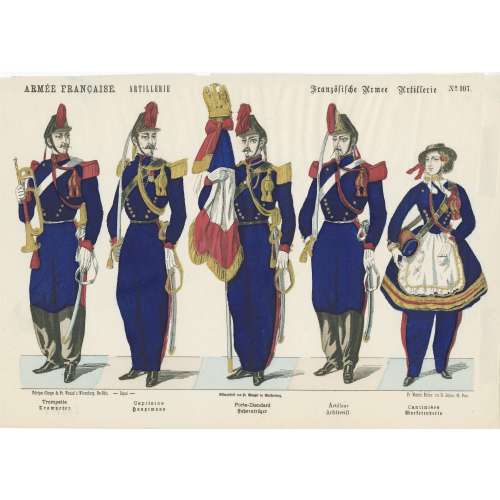 Hand-coloured woodcut on wove paper, 265 x 378 mm; black ink stamp “5051 1” to reverse. Top left: "ARMÉE FRANCAISE. ARTILLERIE"; right: (gothic font) "Französische Armee Artillerie" — "№ 107". Below left: "Fabrique d’Images de Fr. Wentzel à Wissembeurg. Bas-Rhin." — "Déposé" —, centre: "Bilderfabrit von Fr. Wentzel in Weissenburg", right: "Fr. Wentzel, Éditeur, rue St. Jacques, 65, Paris". Bottom: "Trompette | Trompeter" — "Capitaine | Gauptmann" — "Porte-Étendard | Fahnenträger" — "Artilleur | Artillerist" — "Cantinière | Marketenderin". Jean Frédéric Wentzel (French, 1807 – 1869) – publisher/printer.
Hand-coloured woodcut on wove paper, 265 x 378 mm; black ink stamp “5051 1” to reverse. Top left: "ARMÉE FRANCAISE. ARTILLERIE"; right: (gothic font) "Französische Armee Artillerie" — "№ 107". Below left: "Fabrique d’Images de Fr. Wentzel à Wissembeurg. Bas-Rhin." — "Déposé" —, centre: "Bilderfabrit von Fr. Wentzel in Weissenburg", right: "Fr. Wentzel, Éditeur, rue St. Jacques, 65, Paris". Bottom: "Trompette | Trompeter" — "Capitaine | Gauptmann" — "Porte-Étendard | Fahnenträger" — "Artilleur | Artillerist" — "Cantinière | Marketenderin". Jean Frédéric Wentzel (French, 1807 – 1869) – publisher/printer. -
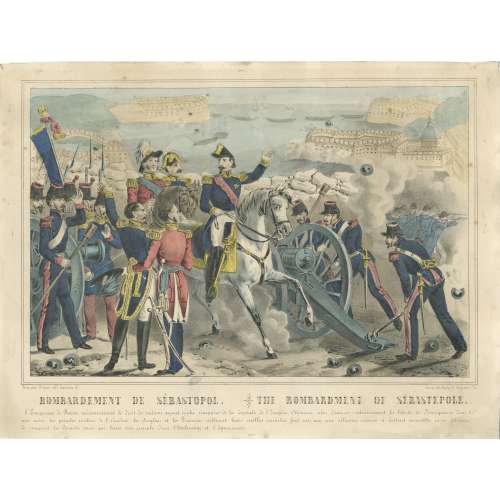 Hand-coloured lithography on wove paper, 250 x 332 mm; black ink stamp “5035” to reverse. Under the frame left: "Paris, chez Riboni, éd. r. Galande, 51"; right: "Paris, lith. Bulla, Pl. Maubert, 26". Below: "BOMBARDEMENT DE SEBASTOPOL. — THE BOMBARDMENT OF SÉBASTOPOLE". Text to bottom. Printers/publishers: Antoine Bulla (fl. 1815 – 1877), François Bulla (fl. c. 1814 – 1855).
Hand-coloured lithography on wove paper, 250 x 332 mm; black ink stamp “5035” to reverse. Under the frame left: "Paris, chez Riboni, éd. r. Galande, 51"; right: "Paris, lith. Bulla, Pl. Maubert, 26". Below: "BOMBARDEMENT DE SEBASTOPOL. — THE BOMBARDMENT OF SÉBASTOPOLE". Text to bottom. Printers/publishers: Antoine Bulla (fl. 1815 – 1877), François Bulla (fl. c. 1814 – 1855). -
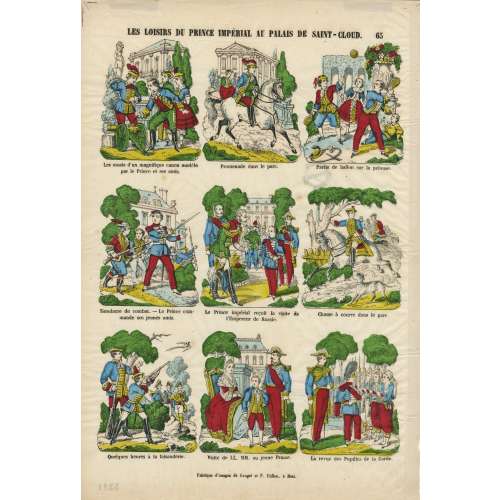 Hand-coloured woodcut on wove paper, 400 x 280 mm; black ink stamp “5321” to reverse. Top: "LES LOISIRS DU PRINCE IMPERIAL AU PALAIS DE SAINT- CLOUD" — "65". Below: nine cartoons with captions.
Hand-coloured woodcut on wove paper, 400 x 280 mm; black ink stamp “5321” to reverse. Top: "LES LOISIRS DU PRINCE IMPERIAL AU PALAIS DE SAINT- CLOUD" — "65". Below: nine cartoons with captions.- Les essais d'un magnifique canon modèle par le Prince et ses amis.
- Promenade dans le parc.
- Partie de ballon sur la pelouse.
- Simulacre de combat. — Le Prince commande ses jeunes amis.
- le Prince impérial reçoit la visite de l'Empereur de Russie.
- Chasse à courre dans le parc.
- Quelques heures à la faisanderie.
- Visite de LL. MM. au jeune Prince.
- La revue des Pupilles de la Garde.
-
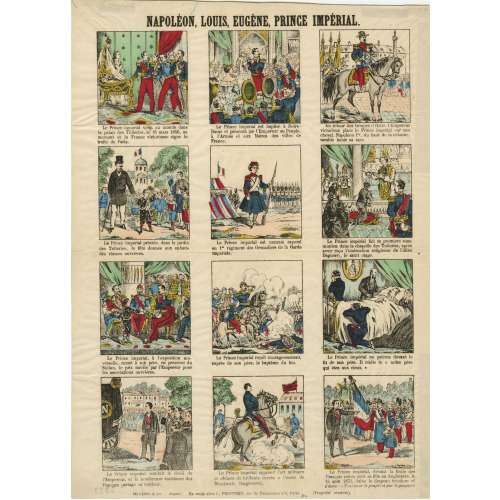 Another copy of SVFC-0745-3.2023, 395 x 290 mm; black ink stamp “5322” to reverse. Jean Charles Pellerin (French, 1756 – 1836)
Another copy of SVFC-0745-3.2023, 395 x 290 mm; black ink stamp “5322” to reverse. Jean Charles Pellerin (French, 1756 – 1836) -
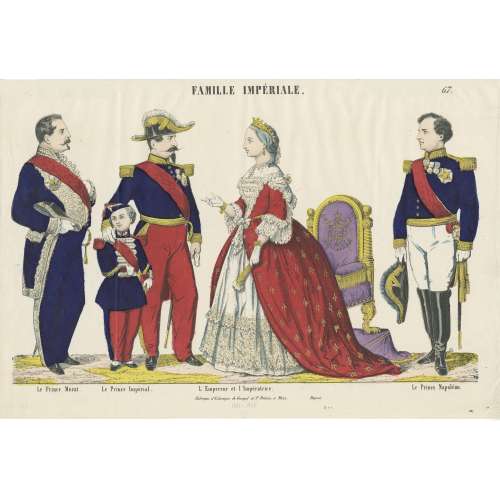 Hand-coloured woodcut on wove paper, 288 x 426 mm; black ink stamp “5305” to reverse. Top centre: "FAMILLE IMPÉRIALE", right: "67." Under the image: "Le Prince Murat." — "Le Prince Impérial." — "L' Empereur et l'Impératrice." — "Le Prince Napoléon." Bottom: "Fabrique d'Estampes de Gangel et P. Didion, à Metz." — "Déposé." Bottom: ms in pencil "1861 – 1868". Publisher/printer: Gangel et P. Didion (Metz); Paulin Didion (French, 1831 – 1879). Characters: Napoleon III [Charles-Louis Napoléon Bonaparte] (French, 1808 – 1873) Eugénie de Montijo [L'impératrice Eugénie] (Spanish-French, 1826 – 1920) Napoléon, Prince Imperial (Napoléon Eugène Louis Jean Joseph Bonaparte] (French, 1856 – 1879) Prince Murat [Lucien Charles Joseph Napoléon] (French, 1803 – 1878) Napoléon-Jérôme Bonaparte [Prince Napoléon] (French, 1822 – 1891)
Hand-coloured woodcut on wove paper, 288 x 426 mm; black ink stamp “5305” to reverse. Top centre: "FAMILLE IMPÉRIALE", right: "67." Under the image: "Le Prince Murat." — "Le Prince Impérial." — "L' Empereur et l'Impératrice." — "Le Prince Napoléon." Bottom: "Fabrique d'Estampes de Gangel et P. Didion, à Metz." — "Déposé." Bottom: ms in pencil "1861 – 1868". Publisher/printer: Gangel et P. Didion (Metz); Paulin Didion (French, 1831 – 1879). Characters: Napoleon III [Charles-Louis Napoléon Bonaparte] (French, 1808 – 1873) Eugénie de Montijo [L'impératrice Eugénie] (Spanish-French, 1826 – 1920) Napoléon, Prince Imperial (Napoléon Eugène Louis Jean Joseph Bonaparte] (French, 1856 – 1879) Prince Murat [Lucien Charles Joseph Napoléon] (French, 1803 – 1878) Napoléon-Jérôme Bonaparte [Prince Napoléon] (French, 1822 – 1891) -
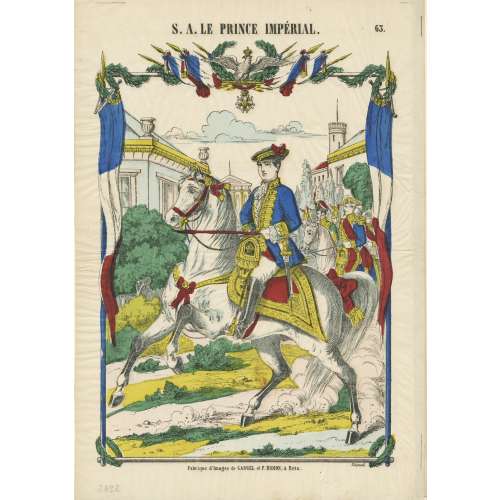 Hand-coloured woodcut on wove paper, 327 x 280 mm; black ink stamp “5265” to reverse, attached to the sheet 470 x 325 mm. Top centre: "S. A. LE PRINCE IMPÉRIAL.", right: "63." Image: equestiral portrait of Prince Impérial. Under the image, centre: "Fabrique d'Images de GANGEL et P. DIDION, à Metz." — "Déposé." Napoléon, Prince Imperial (Napoléon Eugène Louis Jean Joseph Bonaparte] (French, 1856 – 1879). Gangel et P. Didion (Metz); Paulin Didion (French, 1831 – 1879) – publisher/printer.
Hand-coloured woodcut on wove paper, 327 x 280 mm; black ink stamp “5265” to reverse, attached to the sheet 470 x 325 mm. Top centre: "S. A. LE PRINCE IMPÉRIAL.", right: "63." Image: equestiral portrait of Prince Impérial. Under the image, centre: "Fabrique d'Images de GANGEL et P. DIDION, à Metz." — "Déposé." Napoléon, Prince Imperial (Napoléon Eugène Louis Jean Joseph Bonaparte] (French, 1856 – 1879). Gangel et P. Didion (Metz); Paulin Didion (French, 1831 – 1879) – publisher/printer. -
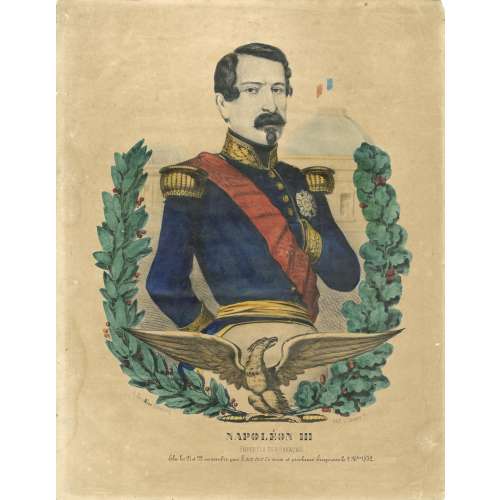 Hand-coloured lithography on wove paper, 380 x 298 mm; black ink stamp “4912” to reverse. On stone left: "A, Paris Miné Éditeur, imp.;" right: "Lith. R. St. Jacques. 41." Bottom center: "Napoléon III"; below: "EMPEREUR DES FRANÇAIS", under: "Élu les 21 el 22 novembre par 8,000,000 de voix et proclamé Empereur le 2 Xbre 1852." Printer/publisher: Miné, éditeur, imprimeur en lithographie, Rue Saint-Jacques, 41. Napoleon III [Charles-Louis Napoléon Bonaparte] (French, 1808 – 1873)
Hand-coloured lithography on wove paper, 380 x 298 mm; black ink stamp “4912” to reverse. On stone left: "A, Paris Miné Éditeur, imp.;" right: "Lith. R. St. Jacques. 41." Bottom center: "Napoléon III"; below: "EMPEREUR DES FRANÇAIS", under: "Élu les 21 el 22 novembre par 8,000,000 de voix et proclamé Empereur le 2 Xbre 1852." Printer/publisher: Miné, éditeur, imprimeur en lithographie, Rue Saint-Jacques, 41. Napoleon III [Charles-Louis Napoléon Bonaparte] (French, 1808 – 1873) -
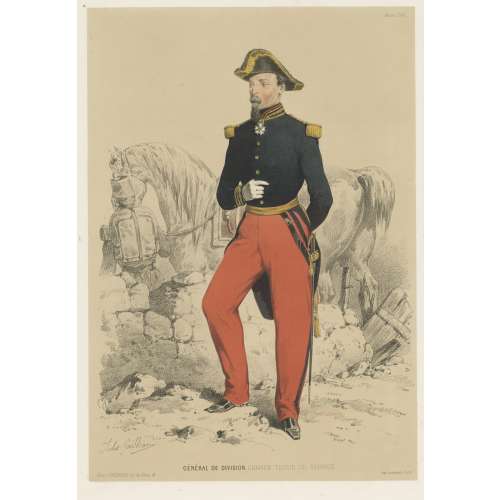 Chromolithography on thick wove paper, 473 x 315 mm sheet, 372 x 260 mm image, black ink stamp “5050” to reverse. Signed on stone "Jules Gaildrau"; below centre: "GÉNERAL DE DIVISION, GRANDE TENUE DE SERVICE"; Bottom left: "Paris, J. Gaildrau, rue de Seine, 16"; right: "Imp. Lemercier, Paris." Joseph Lemercier (French, 1803 – 1887) – printer. Jules Gaildrau (French, 1816 – 1898) – artist.
Chromolithography on thick wove paper, 473 x 315 mm sheet, 372 x 260 mm image, black ink stamp “5050” to reverse. Signed on stone "Jules Gaildrau"; below centre: "GÉNERAL DE DIVISION, GRANDE TENUE DE SERVICE"; Bottom left: "Paris, J. Gaildrau, rue de Seine, 16"; right: "Imp. Lemercier, Paris." Joseph Lemercier (French, 1803 – 1887) – printer. Jules Gaildrau (French, 1816 – 1898) – artist. -
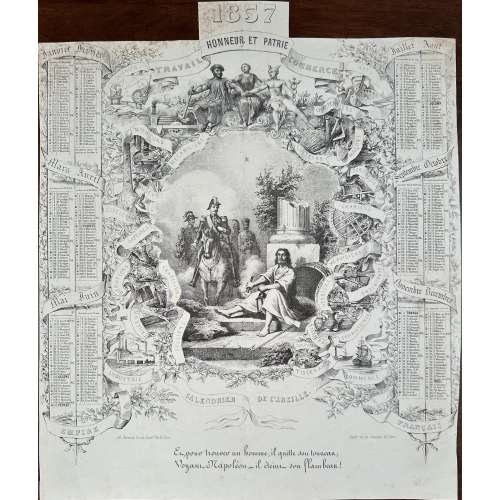 Lithography and etching on wove paper432 x 362 mm, black ink stamp “5022” to reverse, horizontal and vertical centrefolds. Depicts Diogenes (Ancient Greek, 412/404 – 323 BC) beside his barrel and extinguishing his torch when approached by Napoléon III ahorseback. Top: "1857 | HONNEUR ET PATRIE"; lettering on ribbons (top-down): SCIENCES, TRAVAIL, COMMERCE, ARTS, CHARPENTIERS, IMPRIMEURS, "MECHANICIENS, AGRICULTEURS, MAÇONS, FONDEURS, TERRASIERS, CIZELEURS, CARRIERS, ORFEVRES, BIJOUTIERS, CHAPELIERS, MENUISIERS, VERRIERS, SERRURIERS, TAILLEURS, SELLIERS, POTIERS, PORCELAINIERS, CORDONNIERS, TISSERANDS, INDUSTRIE, COMMERCE | CALENDRIER DE L'ABEILLE | EMPIRE, FRANÇAIS. Below left: "lith. Barousse Cour du Comm. 11 et 12. Paris"; right: "Dépôt rue des Cannettes, 20. Paris"; bottom: "Et, pour trouver un homme, il quitte son tonneau, | Voyant Napoléon, – il éteint son flambeau!" [And, to find a man, he leaves his barrel, | Seeing Napoleon, – he extinguishes his torch!]. Six months on the left and six months on the right-hand side of the calendar, surrounding the image.
Lithography and etching on wove paper432 x 362 mm, black ink stamp “5022” to reverse, horizontal and vertical centrefolds. Depicts Diogenes (Ancient Greek, 412/404 – 323 BC) beside his barrel and extinguishing his torch when approached by Napoléon III ahorseback. Top: "1857 | HONNEUR ET PATRIE"; lettering on ribbons (top-down): SCIENCES, TRAVAIL, COMMERCE, ARTS, CHARPENTIERS, IMPRIMEURS, "MECHANICIENS, AGRICULTEURS, MAÇONS, FONDEURS, TERRASIERS, CIZELEURS, CARRIERS, ORFEVRES, BIJOUTIERS, CHAPELIERS, MENUISIERS, VERRIERS, SERRURIERS, TAILLEURS, SELLIERS, POTIERS, PORCELAINIERS, CORDONNIERS, TISSERANDS, INDUSTRIE, COMMERCE | CALENDRIER DE L'ABEILLE | EMPIRE, FRANÇAIS. Below left: "lith. Barousse Cour du Comm. 11 et 12. Paris"; right: "Dépôt rue des Cannettes, 20. Paris"; bottom: "Et, pour trouver un homme, il quitte son tonneau, | Voyant Napoléon, – il éteint son flambeau!" [And, to find a man, he leaves his barrel, | Seeing Napoleon, – he extinguishes his torch!]. Six months on the left and six months on the right-hand side of the calendar, surrounding the image. -
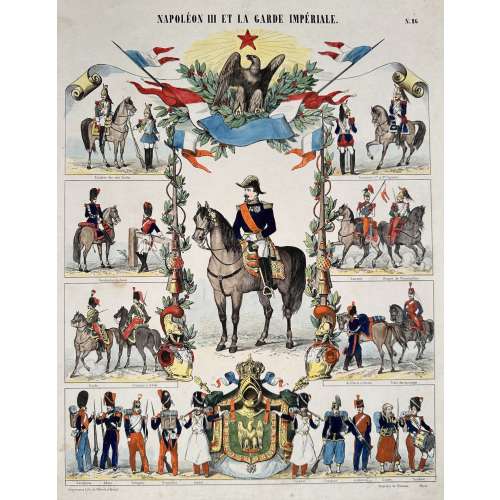 Hand-coloured woodcut on wove paper, 460 x 356 mm; black ink stamp “5055” to reverse. Top centre: "NAPOLÉON III ET LA GARDE IMPÉRIALE"; right: "№ 86". Napoléon III ahorseback in middle, beside (top to bottom): Escadron des cent Gardes — Cuirassiers 1er et 2me regiment; Gendarmes à cheval. — Lancier., Dragon de l’Impératrice.; Guide., Chasseur à cheval. — Artillerie à cheval, Train des équipages.; Gendarme. Génie. Voltigeur. Grenadier. Sapeur. Sapeur. Chasseur. Artillerie. Zouave. Tambour. Bottom left: Imprimerie Lith. de Pellerin à Épinal; right: Propriété de l’Éditeur. Déposé. Jean Charles Pellerin (French, 1756 – 1836) – printer/publisher.
Hand-coloured woodcut on wove paper, 460 x 356 mm; black ink stamp “5055” to reverse. Top centre: "NAPOLÉON III ET LA GARDE IMPÉRIALE"; right: "№ 86". Napoléon III ahorseback in middle, beside (top to bottom): Escadron des cent Gardes — Cuirassiers 1er et 2me regiment; Gendarmes à cheval. — Lancier., Dragon de l’Impératrice.; Guide., Chasseur à cheval. — Artillerie à cheval, Train des équipages.; Gendarme. Génie. Voltigeur. Grenadier. Sapeur. Sapeur. Chasseur. Artillerie. Zouave. Tambour. Bottom left: Imprimerie Lith. de Pellerin à Épinal; right: Propriété de l’Éditeur. Déposé. Jean Charles Pellerin (French, 1756 – 1836) – printer/publisher. -
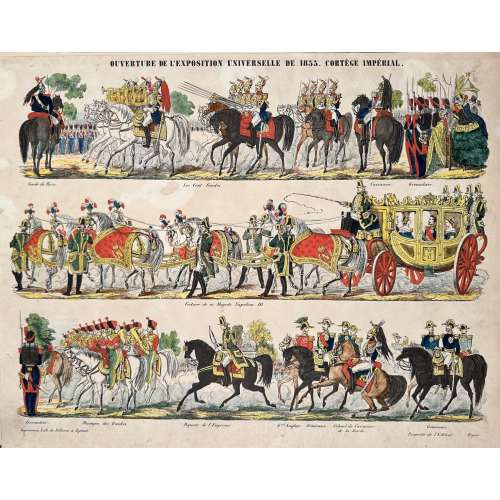 Hand-coloured woodcut on wove paper, 366 x 460 mm; black ink stamp “5057” to reverse. Caption cartoon in 2 tiers. Top: OUVERTURE DE 'EXPOSITION UNIVERSELLE DE 1855. CORTÈGE IMPÉRIAL. Captions top to bottom: Garde de Paris. — Les Cent Gardes. — Cuirassier. — Grenadiers. Middle: Voiture de sa Majesté Napoléon III. | Bottom: Grenadier. — Musique des Guides. — Piqueur de l’Empereur. — Gral Anglais — Généraux — Colonel de Cuirassiers | de la Garde — Généraux. Below left: Imprimerie Lith. de Pellerin, à Épinal; right: Propriété de l’Éditeur. Déposé. Jean Charles Pellerin (French, 1756 – 1836) – printer/publisher.
Hand-coloured woodcut on wove paper, 366 x 460 mm; black ink stamp “5057” to reverse. Caption cartoon in 2 tiers. Top: OUVERTURE DE 'EXPOSITION UNIVERSELLE DE 1855. CORTÈGE IMPÉRIAL. Captions top to bottom: Garde de Paris. — Les Cent Gardes. — Cuirassier. — Grenadiers. Middle: Voiture de sa Majesté Napoléon III. | Bottom: Grenadier. — Musique des Guides. — Piqueur de l’Empereur. — Gral Anglais — Généraux — Colonel de Cuirassiers | de la Garde — Généraux. Below left: Imprimerie Lith. de Pellerin, à Épinal; right: Propriété de l’Éditeur. Déposé. Jean Charles Pellerin (French, 1756 – 1836) – printer/publisher. -
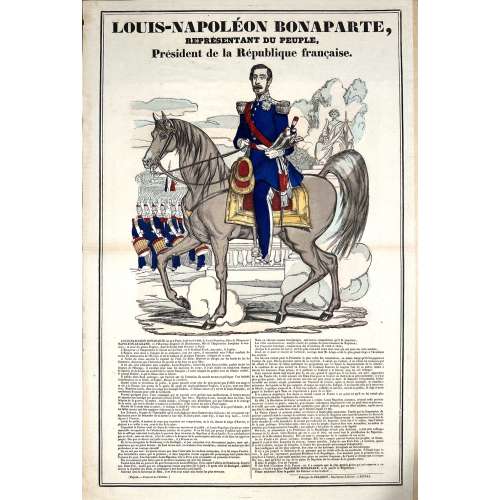 Hand-coloured woodcut poster on wove paper, 622 x 417 mm; black ink stamp “4859” to reverse, horizontal centrefold. In a double frame, top: LOUIS-NAPOLÉON BONAPARTE, | REPRÉSENTANT DU PEUPLE, | Président de la République française. Text under the image ; bottom left: (Déposé.— Propriété de l’Éditeur.); right: Fabrique de PELLERIN, Imprimeur-Libraire, à ÉPINAL. Jean Charles Pellerin (French, 1756 – 1836) – printer/publisher.
Hand-coloured woodcut poster on wove paper, 622 x 417 mm; black ink stamp “4859” to reverse, horizontal centrefold. In a double frame, top: LOUIS-NAPOLÉON BONAPARTE, | REPRÉSENTANT DU PEUPLE, | Président de la République française. Text under the image ; bottom left: (Déposé.— Propriété de l’Éditeur.); right: Fabrique de PELLERIN, Imprimeur-Libraire, à ÉPINAL. Jean Charles Pellerin (French, 1756 – 1836) – printer/publisher. -
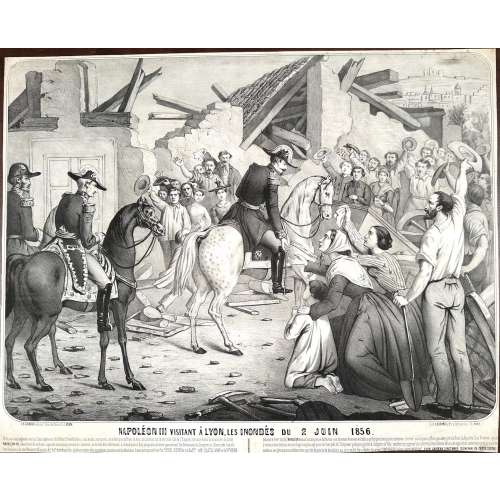 Lithography poster on wove paper, 492 x 614 mm; black ink stamp “5036” to reverse, vertical centerfold. Image in frame; under the frame left: "J. B. Gadola, éditeur. Cours de Brosses 1, à LYON."; right: "Lith LAURANT & Cie r. de Bernardins 34, Paris." Title and text below the image. Jean-Baptiste Gadola (French, 1818 – 1870) – publisher.
Lithography poster on wove paper, 492 x 614 mm; black ink stamp “5036” to reverse, vertical centerfold. Image in frame; under the frame left: "J. B. Gadola, éditeur. Cours de Brosses 1, à LYON."; right: "Lith LAURANT & Cie r. de Bernardins 34, Paris." Title and text below the image. Jean-Baptiste Gadola (French, 1818 – 1870) – publisher. -
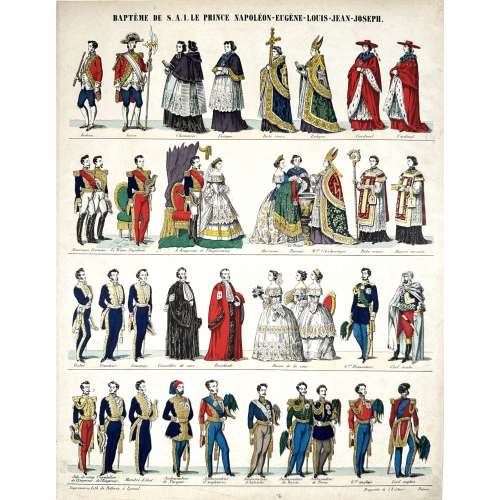 Hand-coloured woodcut on wove paper, 460 x 363 mm; black ink stamp “5054” to reverse. Four tiers with groups of people dressed in uniform, captioned: Bedeau — Suisse — Chanoines — Évêque — Porte croix — Évêque — Cardinal — Cardinal | Généraux français — Le prince Napoléon — L’Empereur et l’Impératrice — Marraine — Le Prince — Parrain | Meur l’Archevêque | Porte crosse Diacre servant | Préfet — Sénateur — Conseiller de cour — Président — Dames de la cour — Gral Piémontais — Chef arabe | Aide-de-camp de l’Empereur — Chambellan de l’Empereur — Ministre d’état — Ambassadeur de Turque | Ambassadeur d’Angleterre — Ambassadeur d’Autriche — Ambassadeur de Russie — Ambassadeur de Prusse — Gral anglaise — Lord anglais || Bottom left: Imprimerie Lith. de Pellerin, à Épinal; right: Propriété de l’Éditeur. — Déposé. Jean Charles Pellerin (French, 1756 – 1836) – printer/publisher.
Hand-coloured woodcut on wove paper, 460 x 363 mm; black ink stamp “5054” to reverse. Four tiers with groups of people dressed in uniform, captioned: Bedeau — Suisse — Chanoines — Évêque — Porte croix — Évêque — Cardinal — Cardinal | Généraux français — Le prince Napoléon — L’Empereur et l’Impératrice — Marraine — Le Prince — Parrain | Meur l’Archevêque | Porte crosse Diacre servant | Préfet — Sénateur — Conseiller de cour — Président — Dames de la cour — Gral Piémontais — Chef arabe | Aide-de-camp de l’Empereur — Chambellan de l’Empereur — Ministre d’état — Ambassadeur de Turque | Ambassadeur d’Angleterre — Ambassadeur d’Autriche — Ambassadeur de Russie — Ambassadeur de Prusse — Gral anglaise — Lord anglais || Bottom left: Imprimerie Lith. de Pellerin, à Épinal; right: Propriété de l’Éditeur. — Déposé. Jean Charles Pellerin (French, 1756 – 1836) – printer/publisher. -
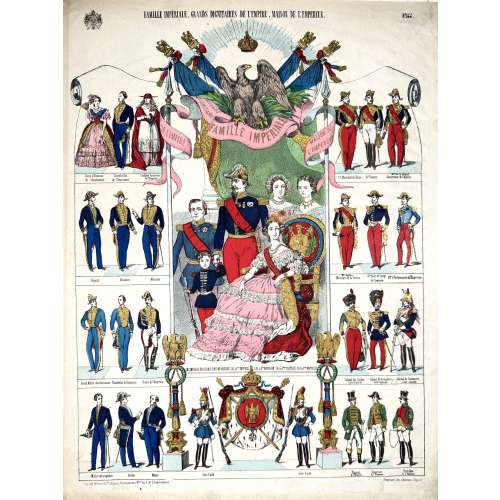 Hand-coloured woodcut on wove paper, 487 x 365 mm; black ink stamp “5056” to reverse. Top left: imperial coat of arms; centre: "FAMILLE IMPERIALE. GRANDS DIGNITAIRES DE L'EMPIRE, MAISON DE L'EMPEREUR."; right: "№144." Image of the imperial family under imperial eagle and standards; besides – four tiers of captioned cartoons. Bottom left: "Imprimerie Lith. de Pellerin, à Épinal"; right: "Propriété de l’Éditeur. — Déposé." Jean Charles Pellerin (French, 1756 – 1836) – printer/publisher.
Hand-coloured woodcut on wove paper, 487 x 365 mm; black ink stamp “5056” to reverse. Top left: imperial coat of arms; centre: "FAMILLE IMPERIALE. GRANDS DIGNITAIRES DE L'EMPIRE, MAISON DE L'EMPEREUR."; right: "№144." Image of the imperial family under imperial eagle and standards; besides – four tiers of captioned cartoons. Bottom left: "Imprimerie Lith. de Pellerin, à Épinal"; right: "Propriété de l’Éditeur. — Déposé." Jean Charles Pellerin (French, 1756 – 1836) – printer/publisher. -
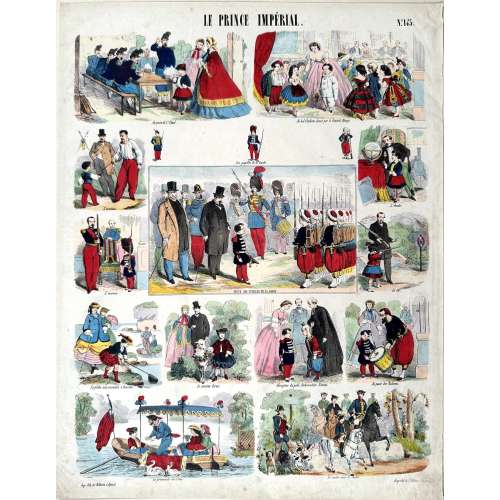 Hand-coloured woodcut on wove paper, 472 x 365 mm; black ink stamp “5275” to reverse. Top centre: "LE PRINCE IMPÉRIAL"; right: "№143." Image in the middle: Prince Impérial, with his father, conducts a review of the children's army "REVUE DES PUPILLES DE LA GARDE". Besides – five tiers of captioned cartoons. Bottom left: "Imp. lith. de Pellerin à Épinal"; right: Propriété de l’Éditeur. Déposé." Jean Charles Pellerin (French, 1756 – 1836) – printer/publisher.
Hand-coloured woodcut on wove paper, 472 x 365 mm; black ink stamp “5275” to reverse. Top centre: "LE PRINCE IMPÉRIAL"; right: "№143." Image in the middle: Prince Impérial, with his father, conducts a review of the children's army "REVUE DES PUPILLES DE LA GARDE". Besides – five tiers of captioned cartoons. Bottom left: "Imp. lith. de Pellerin à Épinal"; right: Propriété de l’Éditeur. Déposé." Jean Charles Pellerin (French, 1756 – 1836) – printer/publisher. -
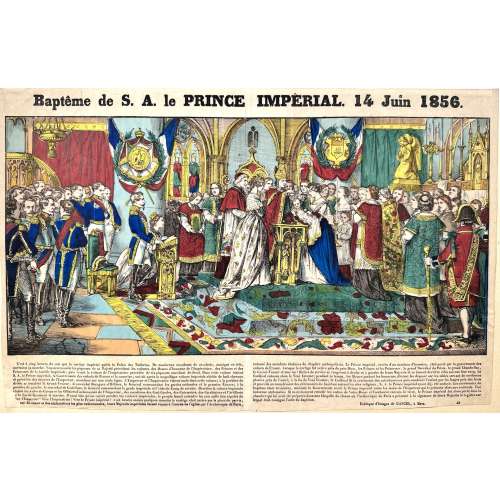 Hand-coloured woodcut on wove paper, 610 x 390 mm; black ink stamp “5207” to reverse, attached to a larger sheet of thick paper with a red ink stamp: “COLLECTION JEAN-CLAUD LACHNITT | REPRODUCTION INTERDIT”. Top: Baptême de S. A. le PRINCE IMPÉRIAL. 14 Juin 1856; image of baptism of Prince-Impérial; two-column text with a small loss in the lower left corner (C'est à cinq heures du soir que le cortège impérial quitta le Palais des Tuileries. De nombreux escadrons de cavalerie, musique en tête ouvraient la marche. ...); bottom under the text: "Fabrique d'Images de GANGEL, à Metz." — "49".
Hand-coloured woodcut on wove paper, 610 x 390 mm; black ink stamp “5207” to reverse, attached to a larger sheet of thick paper with a red ink stamp: “COLLECTION JEAN-CLAUD LACHNITT | REPRODUCTION INTERDIT”. Top: Baptême de S. A. le PRINCE IMPÉRIAL. 14 Juin 1856; image of baptism of Prince-Impérial; two-column text with a small loss in the lower left corner (C'est à cinq heures du soir que le cortège impérial quitta le Palais des Tuileries. De nombreux escadrons de cavalerie, musique en tête ouvraient la marche. ...); bottom under the text: "Fabrique d'Images de GANGEL, à Metz." — "49". -
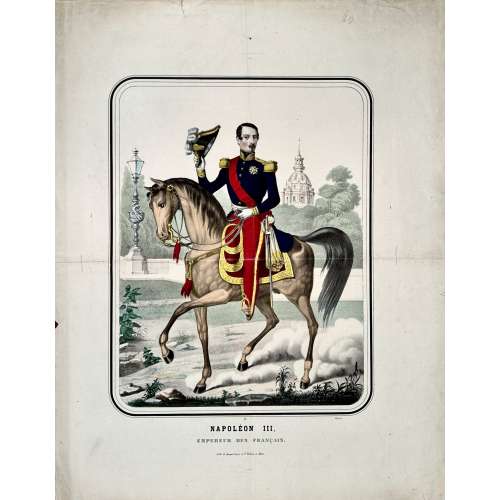 Hand-coloured chromolithography on wove paper, 600 x 470 mm; black ink stamp “4921” to reverse, horizontal and vertical centrefolds. Image of Napoléon III on horseback, in a frame; lettering under the frame: 34 — Déposé | NAPOLÉON III | EMPEREUR DES FRANÇAIS. | Lith. de Gangel frères et P. Didion, à Metz. || Gangel frères et P. Didion (Metz) – printer/publisher. Paulin Didion (French, 1831 – 1879)
Hand-coloured chromolithography on wove paper, 600 x 470 mm; black ink stamp “4921” to reverse, horizontal and vertical centrefolds. Image of Napoléon III on horseback, in a frame; lettering under the frame: 34 — Déposé | NAPOLÉON III | EMPEREUR DES FRANÇAIS. | Lith. de Gangel frères et P. Didion, à Metz. || Gangel frères et P. Didion (Metz) – printer/publisher. Paulin Didion (French, 1831 – 1879) -
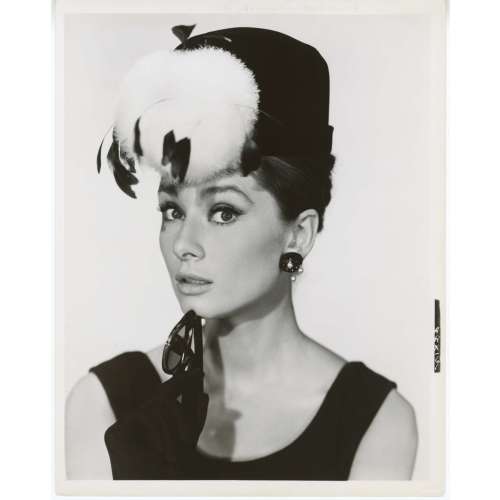 Three-quarter head photographic portrait of British actress Audrey Hepburn, in the American film Breakfast at Tiffany's, shot in 1961 by Paramount Pictures / contemporary gelatin silver print. Inscription to verso (graphite): Audrey Hepburn 1961 | F Breakfast at Tiffany's || Dimensions: 256 x 201 mm. Audrey Hepburn [née Ruston] (British, 1929 – 1993) Paramount Pictures Breakfast at Tiffany's
Three-quarter head photographic portrait of British actress Audrey Hepburn, in the American film Breakfast at Tiffany's, shot in 1961 by Paramount Pictures / contemporary gelatin silver print. Inscription to verso (graphite): Audrey Hepburn 1961 | F Breakfast at Tiffany's || Dimensions: 256 x 201 mm. Audrey Hepburn [née Ruston] (British, 1929 – 1993) Paramount Pictures Breakfast at Tiffany's -
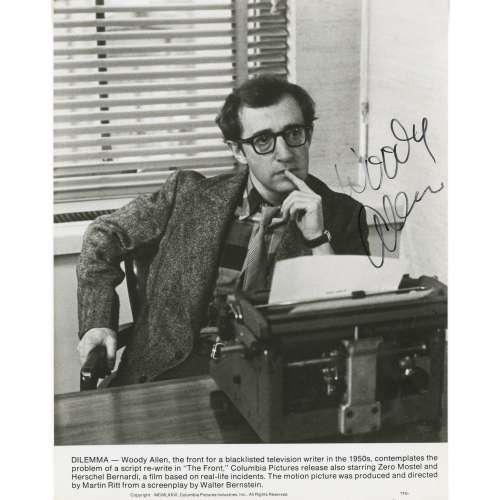 Three-quarter half-length seated portrait of American filmmaker and actor Woody Allen in a scene from the drama film The Front (1976), shot by Columbia Pictures in 1976, autographed on a light area of the image. Dimensions: 245 x 192 mm; image 217 x 192 mm.
Three-quarter half-length seated portrait of American filmmaker and actor Woody Allen in a scene from the drama film The Front (1976), shot by Columbia Pictures in 1976, autographed on a light area of the image. Dimensions: 245 x 192 mm; image 217 x 192 mm. -
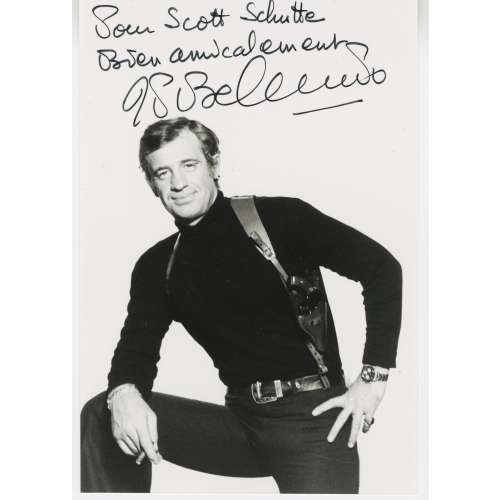 Three-quarter waist portrait of French actor Jean-Paul Belmondo in the film Peur sur la Ville, directed by Henri Verneuil in 1975. Autographed in black ink on a light area of the image above the head: “Pour Scott Schutte | Bien amicalement | J.P. Belmondo”. Paper watermarked "Agfa" in a diamond. Dimensions: 147 x 100 mm
Three-quarter waist portrait of French actor Jean-Paul Belmondo in the film Peur sur la Ville, directed by Henri Verneuil in 1975. Autographed in black ink on a light area of the image above the head: “Pour Scott Schutte | Bien amicalement | J.P. Belmondo”. Paper watermarked "Agfa" in a diamond. Dimensions: 147 x 100 mm -
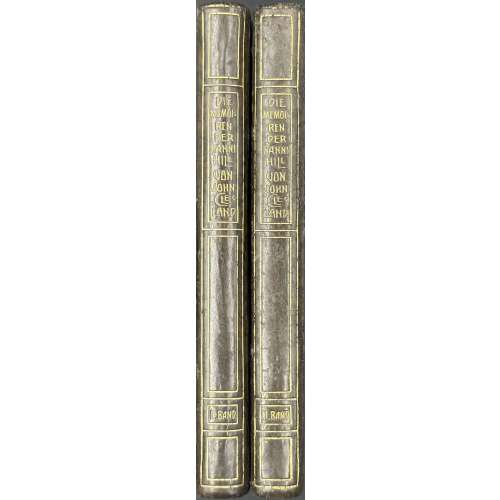 Two hardcover volumes, 17 x 11.5 cm, collated in-8vo, uniformly bound in dark grey mottled calf bordered with gilt fillet, flat spine with gilt lettering in compartments outlined in gilt; top edge gilt, text and plates printed on dense wove paper (Japanpapier). Privately printed by Gustav Röttig & Sohn (Ödenburg) in 800 copies, of which this is copy № 16, signed by von Bayros in 1st vol. Each volume is illustrated with four heliogravures (title-page and three plates) after drawings by Franz von Bayros. According to the seller, this is one of only 35 copies of the deluxe edition on Japanpapier, a fact which was mentioned by the bibliographers but not in the imprint. Bookplate to front pastedown in each volume, lettering to bottom “Ex libris Dr. phil. Rudolf Ludwig”, 120 x 100 mm, heliogravure after von Bayros. Pp.: vol. 1 [4] 1-198 plus engraved t.p. and 3 plates. Vol. 2: 1-204 [2] plus engraved t.p. and 3 plates. Title-page: DIE MEMOIREN | DER | FANNY HILL | VON | JOHN CLELAND | ESTER (ZWEITER) BAND | PAPHOS IM JAHR DER | CYTHERE | MDCCCCVI || Author of the text: John Cleland (British, c. 1709 – 1789). Translator: Franz Blei [Dr. Erich Feldhammer] (Austrian, 1871 – 1942). Illustrator: Franz von Bayros (Austrian, 1866 – 1924). Provenance: Dr. Phil. Rudolf Ludwig. Catalogue raisonné: The amorous drawings of the Marquis von Bayros. — New York: Cythera Press, 1968. The Beautiful Maiden of Pao, pp. 31-38. Seller's Description: Erster [und] Zweiter Band. Paphos [Wien, C. W. Stern], im Jahr der Cythere 1906. Mit sechs Tafeln und zwei illustrierten Titeln nach Franz von Bayros, alle zweifarbig. Grau marmorierte Originalkalblederbände mit Rücken-, Deckelkanten- und Kopfschnittvergoldung. Privatdruck. – Eins von 35 Exemplaren der Luxusausgabe auf Japanpapier, im Druckvermerk von Band I von Bayros signiert. – Die Übersetzung stammt von Franz Blei, der hier unter dem Pseudonym Dr. Erich Feldhammer genannt wird. Als Textvorlage diente die Ausgabe London 1749. – Gedruckt wurde bei Gustav Röttig & Sohn in Ödenburg. – Sehr seltene Vorzugsausgabe, die zwar bei den Bibliographen, nicht aber im Druckvermerk genannt wurde. – Fast tadellos. – »Dieses Werk ist eines der berühmtesten in der erotischen Literatur« (Stern-Szana). Nach Hinweis bei Brettschneider wurde die Auflage beschlagnahmt. – Exlibris Dr. phil. Rudolf Ludwig, Wien (Heliogravüre nach Zeichnung von Franz von Bayros, Brettschneider 156) in beiden Bänden. 17 : 11,5 cm. [4], 198, [2], [4], 204, [2] Seiten. Zusammen 8 Tafeln. Brettschneider 38. – Hayn/Gotendorf I, 618. – Stern-Szana 243 und ausführlich S. 222ff
Two hardcover volumes, 17 x 11.5 cm, collated in-8vo, uniformly bound in dark grey mottled calf bordered with gilt fillet, flat spine with gilt lettering in compartments outlined in gilt; top edge gilt, text and plates printed on dense wove paper (Japanpapier). Privately printed by Gustav Röttig & Sohn (Ödenburg) in 800 copies, of which this is copy № 16, signed by von Bayros in 1st vol. Each volume is illustrated with four heliogravures (title-page and three plates) after drawings by Franz von Bayros. According to the seller, this is one of only 35 copies of the deluxe edition on Japanpapier, a fact which was mentioned by the bibliographers but not in the imprint. Bookplate to front pastedown in each volume, lettering to bottom “Ex libris Dr. phil. Rudolf Ludwig”, 120 x 100 mm, heliogravure after von Bayros. Pp.: vol. 1 [4] 1-198 plus engraved t.p. and 3 plates. Vol. 2: 1-204 [2] plus engraved t.p. and 3 plates. Title-page: DIE MEMOIREN | DER | FANNY HILL | VON | JOHN CLELAND | ESTER (ZWEITER) BAND | PAPHOS IM JAHR DER | CYTHERE | MDCCCCVI || Author of the text: John Cleland (British, c. 1709 – 1789). Translator: Franz Blei [Dr. Erich Feldhammer] (Austrian, 1871 – 1942). Illustrator: Franz von Bayros (Austrian, 1866 – 1924). Provenance: Dr. Phil. Rudolf Ludwig. Catalogue raisonné: The amorous drawings of the Marquis von Bayros. — New York: Cythera Press, 1968. The Beautiful Maiden of Pao, pp. 31-38. Seller's Description: Erster [und] Zweiter Band. Paphos [Wien, C. W. Stern], im Jahr der Cythere 1906. Mit sechs Tafeln und zwei illustrierten Titeln nach Franz von Bayros, alle zweifarbig. Grau marmorierte Originalkalblederbände mit Rücken-, Deckelkanten- und Kopfschnittvergoldung. Privatdruck. – Eins von 35 Exemplaren der Luxusausgabe auf Japanpapier, im Druckvermerk von Band I von Bayros signiert. – Die Übersetzung stammt von Franz Blei, der hier unter dem Pseudonym Dr. Erich Feldhammer genannt wird. Als Textvorlage diente die Ausgabe London 1749. – Gedruckt wurde bei Gustav Röttig & Sohn in Ödenburg. – Sehr seltene Vorzugsausgabe, die zwar bei den Bibliographen, nicht aber im Druckvermerk genannt wurde. – Fast tadellos. – »Dieses Werk ist eines der berühmtesten in der erotischen Literatur« (Stern-Szana). Nach Hinweis bei Brettschneider wurde die Auflage beschlagnahmt. – Exlibris Dr. phil. Rudolf Ludwig, Wien (Heliogravüre nach Zeichnung von Franz von Bayros, Brettschneider 156) in beiden Bänden. 17 : 11,5 cm. [4], 198, [2], [4], 204, [2] Seiten. Zusammen 8 Tafeln. Brettschneider 38. – Hayn/Gotendorf I, 618. – Stern-Szana 243 und ausführlich S. 222ff -
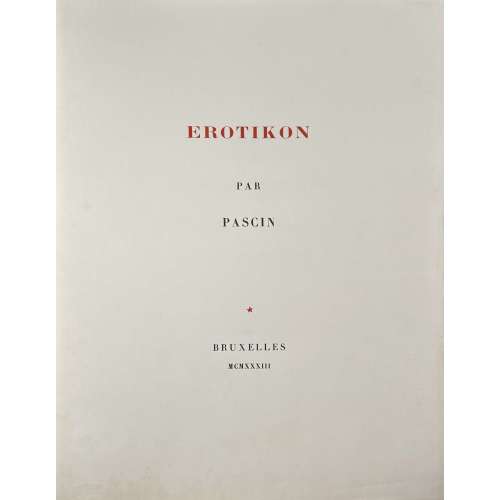 A portfolio of nine heliogravures after Jules Pascin. Cloth-backed cardboard portfolio 420 x 335 mm with 9 heliogravures on slightly tinted india paper, each numbered in pencil and mounted into a passe-partout 410 x 318 mm. Copy № 25 out of 40 printed on india (chine) paper. Copy № 25 of 40. Title (red and black): EROTIKON | PAR | PASCIN | ★ | BRUXELLES | MCMXXXIII || Limitation: CET | ALBUM | A ÉTÉ TIRÉ | A | QUARANTE ET UN EXEMPLAIRES | NUMÉROTÉS | DONT | UN EX. SUR PAPIER ANCIEN | & | QUARANTE EX. SUR CHINE | No (ms 25/40) || Catalogue raisonné: Dutel III № 1498. Seller's description:Neun Heliogravüren. 1933. Meist ca. 30 : 35 cm. Nummeriert. Exemplar 25/40 (Gesamtauflage 41). – Die Heliogravüren auf leicht getöntem China, jedes Blatt mit Bleistift nummeriert und in Passepartouts montiert. – Die neun Passepartouts eingelegt in zwei Büttenumschläge, einer mit Titel und dem nummerierten Auflagenvermerk, der zweite unbedruckt, ferner Büttenumschlag mit Titel in Rotdruck und Halbleinenchemise. – Die Heliogravüren erschienen 1933, drei Jahre nach Pascins Tod bei Daragnes in Paris mit der fingierten Angabe »Brüssel«. – Das berühmte Mappenwerk bildet eine der großen Seltenheiten der erotischen Kunst. Die Motive Pascins beschreibt das Bilderlexikon als »eine Art ›Boheme-Rokoko im Montmartre-Milieu‹« und lobt den Künstler: »Er ist ein außerordentlicher Zeichner, der es versteht, bei allem Zynismus, der seinen exhibitionistischen Charakter nicht verleugnet, auf diesem Kulturdünger eine neuartige Blume voll graziöser Schönheit erblühen zu lassen.« Mappe: 42 : 33,5 cm. – Der äußere Büttenumschlag mit leichtem Wasserrand. – Zwei Heliogravüren minimal stockfleckig, sonst tadellos und absolut vollständig. Dutel 1498 (mit Auflagenvarianten). – Der kalte Blick S. 198ff. – Bilderlexikon II, 718.
A portfolio of nine heliogravures after Jules Pascin. Cloth-backed cardboard portfolio 420 x 335 mm with 9 heliogravures on slightly tinted india paper, each numbered in pencil and mounted into a passe-partout 410 x 318 mm. Copy № 25 out of 40 printed on india (chine) paper. Copy № 25 of 40. Title (red and black): EROTIKON | PAR | PASCIN | ★ | BRUXELLES | MCMXXXIII || Limitation: CET | ALBUM | A ÉTÉ TIRÉ | A | QUARANTE ET UN EXEMPLAIRES | NUMÉROTÉS | DONT | UN EX. SUR PAPIER ANCIEN | & | QUARANTE EX. SUR CHINE | No (ms 25/40) || Catalogue raisonné: Dutel III № 1498. Seller's description:Neun Heliogravüren. 1933. Meist ca. 30 : 35 cm. Nummeriert. Exemplar 25/40 (Gesamtauflage 41). – Die Heliogravüren auf leicht getöntem China, jedes Blatt mit Bleistift nummeriert und in Passepartouts montiert. – Die neun Passepartouts eingelegt in zwei Büttenumschläge, einer mit Titel und dem nummerierten Auflagenvermerk, der zweite unbedruckt, ferner Büttenumschlag mit Titel in Rotdruck und Halbleinenchemise. – Die Heliogravüren erschienen 1933, drei Jahre nach Pascins Tod bei Daragnes in Paris mit der fingierten Angabe »Brüssel«. – Das berühmte Mappenwerk bildet eine der großen Seltenheiten der erotischen Kunst. Die Motive Pascins beschreibt das Bilderlexikon als »eine Art ›Boheme-Rokoko im Montmartre-Milieu‹« und lobt den Künstler: »Er ist ein außerordentlicher Zeichner, der es versteht, bei allem Zynismus, der seinen exhibitionistischen Charakter nicht verleugnet, auf diesem Kulturdünger eine neuartige Blume voll graziöser Schönheit erblühen zu lassen.« Mappe: 42 : 33,5 cm. – Der äußere Büttenumschlag mit leichtem Wasserrand. – Zwei Heliogravüren minimal stockfleckig, sonst tadellos und absolut vollständig. Dutel 1498 (mit Auflagenvarianten). – Der kalte Blick S. 198ff. – Bilderlexikon II, 718. -
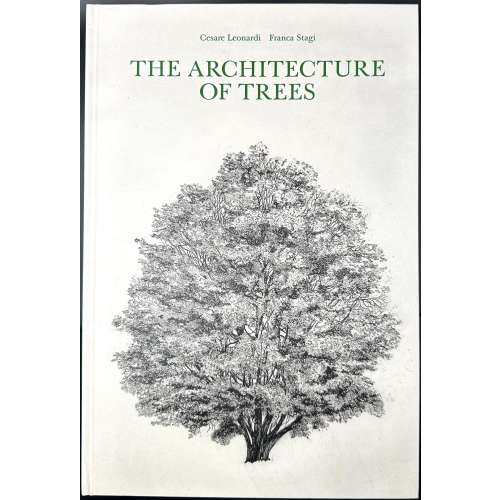 Hardcover volume, 38.3 x 26 x 3.8 cm, pictorial boards, lettering to front cover and spine, pp.: [1-6] 7-421 [3], ils. Title-page: Cesare Leonardi Franca Stagi | THE ARCHITECTURE | OF TREES | Introduction to the new edition | ANDREA CAVANI, GIULIO ORSINI | Translated from the Italian by | NATALIE DANFORD | Princeton Architectural Press | New York || Cesare Leonardi (Italian, 1935 – 2021) Franca Stagi (Italian, 1937 – 2008) Natalie Danford (American, b. 1968)
Hardcover volume, 38.3 x 26 x 3.8 cm, pictorial boards, lettering to front cover and spine, pp.: [1-6] 7-421 [3], ils. Title-page: Cesare Leonardi Franca Stagi | THE ARCHITECTURE | OF TREES | Introduction to the new edition | ANDREA CAVANI, GIULIO ORSINI | Translated from the Italian by | NATALIE DANFORD | Princeton Architectural Press | New York || Cesare Leonardi (Italian, 1935 – 2021) Franca Stagi (Italian, 1937 – 2008) Natalie Danford (American, b. 1968) -
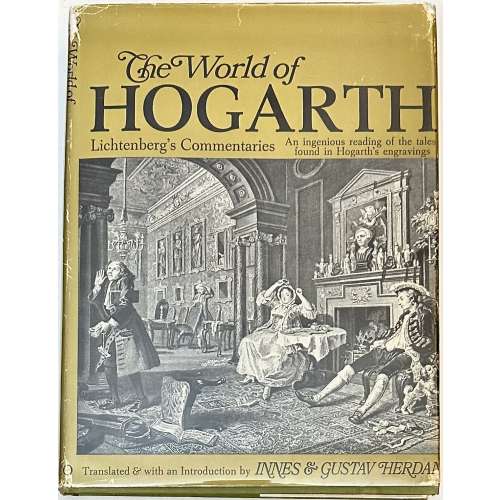 Hardcover volume, 25.3 x 19.3 cm, green cloth with gilt lettering to front and spine, pictorial dust jacket, pp.: [1 blank] [i-viii] ix-xxiii [xxiv blank] [2] 3-297 [298 blank] [8 blanks], 26 plates, unpaginated. MS inscription in black ink to ffl “David Tatham 1969”. Title-page: The World of | HOGARTH | Lichtenberg's Commentaries | on Hogarth's Engravings | TRANSLATED FROM THE GERMAN | AND WITH AN INTRODUCTION BY | INNES AND GUSTAV HERDAN | HOUGHTON MIFFLIN COMPANY BOSTON | The Riverside Press Cambridge | 1966 || Illustrations: A Harlot's Progress; Marriage-à-la-Mode; Strolling Actresses Dressing in a Barn; A Midnight Modern Conversation or The Bacchanalians; A Rake's Progress; The Four Times of the Day: Morning, Noon, Evening, Night. Edition: First printing w; Printed in the United States of America. Provenance (possibly): David Tatham (American, 1932 – 2023) Contributors: George Christoph Lichtenberg (German, 1743 – 1799) Innes Herdan (British, 1911 – ?) Gustav Herdan (German, 1897 – 1968) William Hogarth (British, 1697 – 1764)
Hardcover volume, 25.3 x 19.3 cm, green cloth with gilt lettering to front and spine, pictorial dust jacket, pp.: [1 blank] [i-viii] ix-xxiii [xxiv blank] [2] 3-297 [298 blank] [8 blanks], 26 plates, unpaginated. MS inscription in black ink to ffl “David Tatham 1969”. Title-page: The World of | HOGARTH | Lichtenberg's Commentaries | on Hogarth's Engravings | TRANSLATED FROM THE GERMAN | AND WITH AN INTRODUCTION BY | INNES AND GUSTAV HERDAN | HOUGHTON MIFFLIN COMPANY BOSTON | The Riverside Press Cambridge | 1966 || Illustrations: A Harlot's Progress; Marriage-à-la-Mode; Strolling Actresses Dressing in a Barn; A Midnight Modern Conversation or The Bacchanalians; A Rake's Progress; The Four Times of the Day: Morning, Noon, Evening, Night. Edition: First printing w; Printed in the United States of America. Provenance (possibly): David Tatham (American, 1932 – 2023) Contributors: George Christoph Lichtenberg (German, 1743 – 1799) Innes Herdan (British, 1911 – ?) Gustav Herdan (German, 1897 – 1968) William Hogarth (British, 1697 – 1764)


